Text
Explore Tampa, Fla., for a summer getaway

Panoramic views of the Downtown Tampa from the rooftop at the Aloft Hotel (Courtesy of Chris Bartlett)
Check out my latest column
Editor’s note: Chris Bartlett, co-founder and co-host of Worth Tasting, contributed to this column.
Summer travel plans are in the making. A summer vacation in Tampa, Fla. … why not? With these accolades, it makes it the perfect area to explore.
• Tampa Bay is 2023’s sevent-best summer travel destination (WalletHub)
• Tampa was awarded one of the Best Places to Travel (Money)
• Three Tampa neighborhoods were ranked in the top 10 of the 2024 list of Best Places to live in America. (Niche)
• Tampa was named the 12th “Most Fun Cities in America.” (WalletHub)
• Tampa Riverwalk was voted second-best Riverwalk in the U.S. (USA Today)
• Tampa was named one of the greatest places in the world (TIME)
• Tampa ranks among the Top 10 cities to visit with kids (Tampa Bay Business Journal)
• Tampa Bay area ranked as best spot to take a vacation with your pet (Tampa Bay Times)
And, for culinary enthusiasts…
• Tampa is first among unexpectedly awesome coffee cities (Livability)
• Tampa was 2022’s eighth-best Foodie City in America (WalletHub)
• Tampa is 2022’s eighth-best City for Vegans and Vegetarians (WalletHub)
• With all of this notoriety would you believe…Tampa was named one of the 15 U.S. tourist hotspots nobody cared about 15 years ago (Orbitz).
Recently, I wrote about the Hyde Park area of the city: https://bit.ly/3Uhgqqg.
Today, I’ll be highlighting the Midtown district experience.
Sometimes the best vacation spots offer the optimal combination of convenience and neighborhood vibe. And when location is important, oftentimes the middle of it all fits the bill.

Midtown Tampa’s website says it all: “You don’t just visit Midtown Tampa – you explore it. From art-lined walkways to lakeside trails, find your flow through our urban district. You’ve never met a place like us.” (Courtesy of Chris Bartlett)
Such is the case with Midtown Tampa, and the Aloft Hotel, one of two anchor hotels (Element Hotel is adjacent) in the district. When you’re in Midtown, most of what visitors would want to do in Tampa is drivable within 5 to 15 minutes.
On the “campus” of Midtown Tampa, there’s great shopping, strolling, sipping and dining options (more on this later). The highlight here for us is Sal Y Mar, the glittering gem of a restaurant and bar perched upon the oasis on the rooftop of the Aloft Hotel.
t’s from here that one can clearly understand both the layout of this district, and its proximity relative to downtown Tampa, with its fabulously diverse neighborhoods.
This curated neighborhood has a uniquely interesting dynamic. Pretty quickly, we came to catch the staycation vibe that it gives off between the hundreds of luxe apartments to the hotels, vibrant culinary scene, entertainment, spas, coffee shops, boutiques and retailers like REI, a Seattle based, outdoor gear company that pioneered the industry.
Here in Midtown people live and work, stay and play, all threading themselves in and around, across and between, these Midtown establishments.
Basing your Tampa vacation here makes it convenient to all the Bay-area attractions. Additionally, it’s the perfect place to simply enjoy what Midtown has to offer — on foot without a car.
Sunshine and sunset markets, yoga and aerobics, plus other fun and health-focused activities in The Commons; you’ll see there’s enough to do right here. After some activity, plunge into the rooftop pool at the Aloft while you soak in some sunshine. You’ll enjoy the panoramic views while sipping on your favorite beverage from the poolside snack bar.

An oasis awaits at the rooftop pool at the Aloft Hotel. (Courtesy of Stephen Fries)
You won’t want to miss a dining experience or two at Sal Y Mar, the hotel’s well-respected, and renowned, rooftop restaurant and lounge, which welcomes both hotel guests and locals.
The Tulum (a Mexican coastal town)-inspired restaurant and menu boasts Tampa Bay views from the covered terrace, if you choose alfresco dining, or via the window wall from inside its inviting and relaxing interior.
Heading up the culinary team is Executive Chef Johnathan Rodriguez, who received the Best Chef Award at Savor St. Pete Food & Wine Festival in 2022 and 2023 in addition to the Taste of Clearwater’s Chef Inspired Award among other accolades.
He gives credit to the chefs at the Michelin- grade restaurants where he’s previously worked, who have influenced and inspired his brilliant attention to detail, and various flavor profiles savored today by guests of Sal Y Mar.
Our Sal Y Mar experience began with the award-winning Tuna Tataki (ahi tuna, soy caviar, wakame, wasabi aioli, fried wonton, pickled ginger, sesame seeds). The seafood trio that followed our entrée includes a lobster crab cake (lump crab meat, lobster, mustard sauce, melted heirloom tomato), a huge and delectable grilled scallop and pan seared shrimp prepared with white wine and herb butter alongside grilled radicchio, drizzled with ginger lime sauce and chimichurri rice. And yes, it is as tantalizing to the palate as it sounds.
To top-off this seafood extravaganza, mouthwatering Cinnamon Churros arrived, complete with caramel dipping sauce… ”the icing on the cake.” We couldn’t resist the Sal Y Mar Flan, well worth the indulgence.

Sal Y Mar, the rooftop restaurant at The Aloft, serves up a heavenly flan. (Courtesy of Chris Bartlett)
For those into beef, the Sal Y Mar Tomahawk Experience should fit the bill…a 32–34-ounce ginormous, bone-in steak, truffle oil, chimichurri sauce, Maldon salt …enough for two or three. Too big?…. the 6 -ounce filet mignon, a 16-ounce ribeye, or Australian rack of lamb are other meat-eater options.
Chef Johnathan shared two recipes. The award-winning Tuna Tataki recipe is at https://stephenfries.com/recipes. The Prime New York Steak With Truffle Burrata Mash and Sautéed Broccolini is below.
The 20 acres that comprise Midtown Tampa are jam packed with everything from a fast-casual, superfood eatery called Kale Me Crazy (so fresh and satisfying) to the comfort and familiarity of a Shake Shack amid so many more diverse and delicious culinary spots to experience. We ate at and tried almost all of them.
From the Louisiana-inspired Gumbo and Ragin’ Red Fish With Creole sauce at Walk-On’s Sports Bistreaux to the delectable, fresh trout at True Food Kitchen, there’s a food place sure to please any palate.
Between our many meals, we made time for a great cup of coffee and sweet treat at Joffrey’s Coffee & Tea Co., extraordinarily luscious and unforgettable truffles at William Dean Chocolates and tasty, fresh salads at the Whole Foods “on campus.”
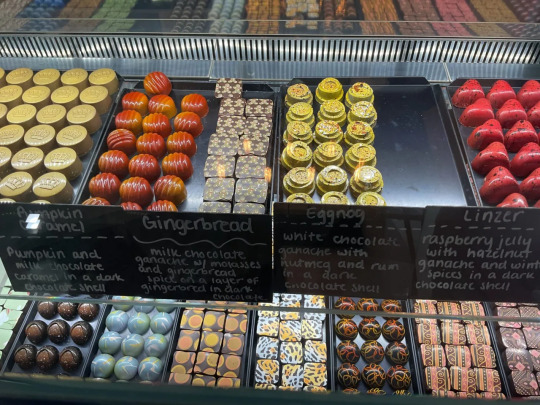
The jewel-looking “works of art” at William Dean Chocolates “excite the eye and intrigue the palate” One of the many shops around the commons at Midtown Tampa. (Courtesy of Stephen Fries)
Two extremely busy places to which we couldn’t secure reservations looked sublime and are high on our next time list; both Sunda Tampa Southeast Asian and Ponte Modern American, owned by Chef Chris Ponte of the iconic Ponte Grill, formerly in nearby Clearwater.
Unfortunately, time ran out before we could sink our teeth into some very amazing-looking pasta dishes we saw coming to guests’ tables while strolling by BellaBrava Tampa, right around the corner.
Prime New York Steak With Truffle Burrata Mash and Sautéed Broccolini
Servings: 2
Ingredients:
Steak:
2 prime New York strips
Kosher salt and freshly ground black pepper, to taste
Olive oil to coat pan
2 tablespoon butter
1 bunch thyme
3 garlic cloves, smashed
Directions:
Pat steaks dry. Season with the salt and pepper on both sides. Heat your choice of pan with oil over medium-high, then place the steak in when the oil is hot. Sear for 3 to 4 minutes on both sides and don’t forget the edges about a minute on those.
Turn the heat down to medium and add the butter, thyme and garlic smash, basting that sauce over the steaks until the internal temperature is 140 degrees. Remove the steak from heat and let the steaks rest to reach a perfect medium steak temperature.
Burrata Truffle Mash:
4 Yukon Gold potatoes, peeled and cut into 1-inch chunks
Kosher salt
4 tablespoons truffle oil
1/3 cup heavy cream
4 tablespoons butter
¼ cup whole milk
2 balls burrata
Kosher salt and freshly ground black pepper, to taste
Directions:
Fill a large pot with cold water. Season with 2 tablespoon kosher salt and carefully add the potatoes. Gently boil potatoes over medium heat for 15 to 20 minutes, until the potatoes are tender. Reserve 1 cup of the cooking water and then drain the potatoes. Return the drained potatoes back to the pot and, using a potato masher or hand mixer, whip the potatoes until mashed.
Add the truffle oil, cream, butter and milk to the potatoes and whip until light and fluffy. Pull the burrata cheese into pieces and add to the potato mash. Mix in with a spoon until melted. Season to taste with salt and pepper. Use the reserved potato cooking water to thin the potatoes to get a very creamy texture, if necessary.
Sauteéd Broccolini:
1 bunch broccolini (about 5 ounces), washed trimmed, halved lengthwise (if thick)
2 tablespoons extra-virgin olive oil
3 garlic cloves, minced
¼ cup of white wine
2 tablespoons butter
Kosher salt and freshly ground black pepper, to taste
Directions:
Cut off and discard the dried ends of the broccolini stems. Cut the broccolini in a bias or thick medallion. Then heat your choice of pan and add the olive oil until it reaches medium heat. Add minced garlic, white wine and cook for 30 seconds to infuse the flavor and to reduce the wine, add the broccolini and a little salt and pepper.
Stir occasionally, for 2 minutes, creating steam in the pan to help the broccolini stems soften. Add a couple tablespoons of water and butter and cover the pan. Reduce the heat to medium-low and cook covered for 2 to 4 minutes until the veggies are tender and bright green.
Stephen Fries is professor emeritus and former coordinator of the Hospitality Management Programs at Gateway Community College in New Haven, Conn. He has been a food and culinary travel columnist for the past 16 years and is co-founder of and host of “Worth Tasting,” a culinary walking tour of downtown New Haven. He is a board member of the International Association of Culinary Professionals. Email him at [email protected]. For more, go to stephenfries.com.
0 notes
Text
Popularity of grains, beans is growing

While dining out during a recent trip, I noticed that the restaurants had several dishes where beans and grains were mentioned in the item’s name or description. Looking at some old menus in my archives, it was rare to see items with beans and grains mentioned. Today, in the United States, their popularity is growing by leaps and bounds.
There are many reasons: health benefits, affordability, interest in plant-based diets, cultural influences, many grains are gluten-free, sustainability and versatility.
Talking about versatility; brownies made with black beans (they’re quite good, and people won’t know what the secret ingredient is), burgers made with a variety of beans, bean-based dips (have you tried a dessert hummus with chocolate as an ingredient?), grains in salads and soups, grains such as quinoa and oats in smoothies as well as grains and beans in those popular breakfast and lunch bowls.
All it takes is creativity to prepare nutritious and flavorful dishes using beans and grains in recipes.
A staple in many cuisines around the globe, especially China, Mexico, India and Brazil, beans and grains have been nourishing the world for thousands of years.
Did you know?
• Lentils were eaten 13,000 years ago in the Middle East.
• Beans are considered symbols of good luck and prosperity in many cultures. In regions in the United States, it is customary to eat black-eyed peas on New Year’s Day. They are eaten at Rosh Hashana, the Jewish New Year as a symbol of a prosperous year ahead. A good friend from Brazil prepares lentils on New Year’s Eve, symbolizing wealth and good fortune, his culture’s tradition he continues here in the U.S.
• Beans come in all shapes, colors and sizes, and come in thousands of varieties.
• Quinoa (a complete protein on its own), farro, spelt and amaranth are ancient grains that have gained popularity due to their health and nutritional benefits. They were part of the diet of ancient civilizations. Everything old is new again!
• Rice, millet, sorghum, buckwheat and rice are among the gluten-free grains, the perfect option for those with diet restrictions.
My goal to include more beans and grains in my diet led me to getting a copy of “The Complete Beans & Grains Cookbook: A Comprehensive Guide with 450+ Recipes,” by the editors of America’s Test Kitchen (2024, $34.99)
And complete it is…. before presenting the recipes, there is an in-depth discussion about beans. You’ll learn about common beans vs. heirloom beans, colors and flavors. There is a compilation of two dozen dried beans used in the recipes. Each bean is discussed in detail, including tasting notes and the recipes they are used in.
From here you’ll master how to cook dried beans resulting in the perfect flavor and texture. For those who prefer to use the convenience of canned beans, that’s covered, too. This is followed by a primer about lentils, a member of the legume family as well as other legumes such as fava beans, green beans, peanuts and soybean varieties.
Then, it’s onto grains: common, whole and heirloom. Twenty-one grains are discussed in detail, plus which recipes they are used in. Then, how to cook grains along with a helpful chart to keep handy. The next section is about varieties of rice used in the recipes along with a rice cooking chart. Concluding the introduction is the equipment that was tested by the test kitchen to cook beans, grains and rice.
Along with the signature headnotes, for which America’s Test Kitchen is known, the recipes that call for heirloom bean and grain varieties that might be more difficult to find, and a-bit-more-expensive, substitutions for a common grocery store alternative, are given. In a hurry…recipes that can be prepared in 45 minutes or less are flagged.
The editors said:“ Even if you are an old hand at cooking beans and grains, there are hundreds of inventive recipes waiting for you. There are traditional recipes for Hoppin’ John, Tacu Tacu and Adasi. There are comfort classics including New England Baked Beans, Ribollita and Arroz con Pollo. There are celebratory dinners such as Chickpea Bouillabaisse, Kibbeh bil Sanieh and Plov.
Let’s get started with these recipes ….
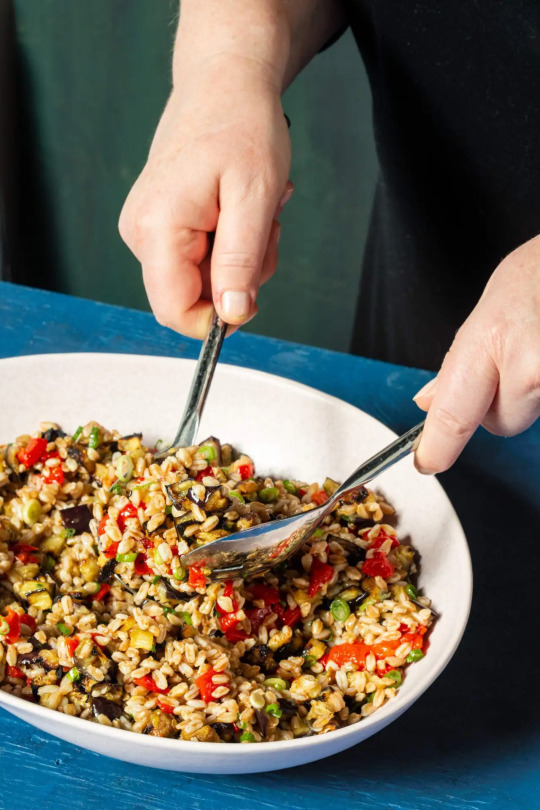
Nutty, earthy farro is one of the fastest-cooking whole grains around, and it works to make the perfect good-for-you Farro Salad With Roasted Eggplant. (Courtesy of America’s Test Kitchen)
Farro Salad with Roasted Eggplant
Serves: 4 to 6
Total time: 1¼ hours
The headnote says: “Why this recipe works: Nutty, earthy farro is one of the fastest-cooking whole grains around, and it works to make the perfect good-for-you grain salad. While the farro cooks, we broil cubed eggplant until it’s nice and brown, which brings essential meatiness and savory, caramelized flavor to the salad. A hefty amount of jarred, roasted red peppers add sweetness and extra veggie goodness.
“Once the farro is cooled, we toss everything together with thinly sliced scallions and a lemony dressing that permeates the whole dish. Do not use pearl, quick-cooking, or pre-steamed farro (check the ingredient list on the package to determine this) in place of the whole farro.”
Ingredients:
1½ cups whole farro
½ teaspoon table salt, plus salt for cooking farro
1½ pounds eggplant, cut into ½‑inch pieces
6 tablespoons extra-virgin olive oil, divided
1 teaspoon grated lemon zest plus 1 tablespoon juice
1½ cups jarred roasted red peppers, rinsed, patted dry, and cut into ½‑inch pieces
3 scallions, sliced thin
¼ teaspoon pepper
Directions:
1. Adjust oven rack 4 inches from broiler element and heat broiler. Bring 4 quarts water to boil in large pot. Add farro and 1 tablespoon salt and cook until grains are tender with slight chew, 15 to 30 minutes. Drain farro, spread onto rimmed baking sheet, and let cool for 15 minutes.
2. Meanwhile, toss eggplant with 3 tablespoons oil, then transfer to aluminum foil–lined rimmed baking sheet and spread into even layer. Broil eggplant until well browned, 15 to 17 minutes, stirring halfway through.
3. Whisk remaining 3 tablespoons oil and lemon zest and juice together in large bowl. Add cooled farro, eggplant, red peppers, scallions, pepper, and salt and toss to combine. Season with salt and pepper to taste. Serve.

Buckwheat Tabbouleh features bulgur parsley, mint and chopped tomatoes tossed in a bright lemon vinaigrette, classic Mediterranean tabbouleh has a refreshing flavor profile that makes it a great light side. (Courtesy of America’s Test Kitchen)
Buckwheat Tabbouleh
Serves: 4
Total time: 35 minutes, plus 45 minutes cooling and resting
The headnote says: “Why this recipe works: Featuring bulgur (a product of the wheat berry), parsley, mint and chopped tomatoes tossed in a bright lemon vinaigrette, classic Mediterranean tabbouleh has a refreshing flavor profile that makes it a great light side. To give this classic our own spin, we swap the bulgur for another grain: mild, appealingly earthy, buckwheat groats.
“Because buckwheat contains a fair amount of starch, we make sure to cook it pasta-style in plenty of water; the water washes away the excess starch, producing separate, evenly cooked kernels. For the herbs, we add plenty of fresh, peppery parsley; 1½ cups has just enough of a presence to balance well with ½ cup of fresh mint. To ensure undiluted, bright flavor in the final tabbouleh, we salt the tomatoes to rid them of excess moisture before tossing them into the salad.”
Ingredients:
¾ cup buckwheat groats, rinsed
½ teaspoon table salt, divided, plus salt for cooking buckwheat
3 tomatoes, cored and cut into ½-inch pieces
2 tablespoons lemon juice
Pinch cayenne pepper
¼ cup extra-virgin olive oil
1½ cups minced fresh parsley
½ cup minced fresh mint
2 scallions, sliced thin
Directions:
1. Bring 2 quarts water to boil in large saucepan. Stir in buckwheat and 2 teaspoons salt. Return to boil, then reduce to simmer and cook until tender, 10 to 12 minutes. Drain well. Spread buckwheat on rimmed baking sheet and let cool for 15 minutes. (Buckwheat can be refrigerated in airtight container for up to 2 days.)
2. Meanwhile, toss tomatoes with ¼ teaspoon salt in bowl. Transfer to fine-mesh strainer, set strainer in bowl, and let sit for 30 minutes, tossing occasionally.
3. Whisk lemon juice, cayenne, and remaining ¼ teaspoon salt together in large bowl. Whisking constantly, drizzle in oil.
4. Add drained tomatoes, cooled buckwheat, parsley, mint, and scallions and gently toss to combine. Cover and let sit at room temperature until flavors meld, at least 30 minutes or up to 2 hours. Toss to recombine and season with salt and pepper to taste. Serve.

Corn Pudding is a rustic, souffle-like casserole. (Courtesy of America’s Test Kitchen)
Corn Pudding
Serves: 6 to 8
Total time: 1 hour
The headnote says: “Why this recipe works: Recipes for this rustic, soufflélike casserole, a traditional part of many a Thanksgiving spread, often call for boxed corn muffin mix and canned cream corn, but here we opt for a fresher take. We swap out the creamed corn for frozen corn kernels, which have a better texture and more flavor than canned. To ensure a silky base brimming with the flavor of sweet corn, we buzz some of the kernels with cream in a blender.
“In place of the boxed muffin mix, we simply combine flour, cornmeal, salt, sugar, and a touch of baking soda; for rich flavor and light texture, we add sour cream and melted butter. Baking the mixture for 35 minutes in a 400-degree oven sets the pudding without drying it out.”
Ingredients:
1 pound frozen corn
¾ cup heavy cream
½ cup (2½ ounces) all-purpose flour
⅓ cup (1⅔ ounces) cornmeal
¼ cup (1¾ ounces) sugar
1¼ teaspoons table salt
¼ teaspoon baking soda
1 cup sour cream
6 tablespoons unsalted butter, melted
1 large egg, lightly beaten
Directions:
1. Adjust oven rack to upper-middle position and heat oven to 400 degrees. Grease 8-inch square baking dish. Combine corn and ¼ cup water in microwave-safe bowl. Cover and microwave until corn is tender, about 7 minutes. Drain corn.
2. Combine cream and 1½ cups corn in blender and process until coarse puree forms, about 30 seconds. Whisk flour, cornmeal, sugar, salt, and baking soda together in large bowl. Whisk sour cream, melted butter, egg, pureed corn mixture, and remaining corn together in separate bowl. Whisk sour cream mixture into flour mixture until combined. Transfer batter to prepared dish.
3. Bake until edges of pudding are lightly browned and top is slightly puffed, about 35 minutes. Let cool on wire rack for 10 minutes. Serve warm.
Recipes courtesy of America’s Test Kitchen.

Stephen Fries is professor emeritus and former coordinator of the Hospitality Management Programs at Gateway Community College in New Haven, Conn. He has been a food and culinary travel columnist for the past 16 years and is co-founder of and host of “Worth Tasting,” a culinary walking tour of downtown New Haven. He is a board member of the International Association of Culinary Professionals. Email him at [email protected]. For more, go to stephenfries.com.
0 notes
Text
Maple syrup is a delicious natural sweetener

A sugarhouse, where maple syrup is produced. (iyd39/Shutterstock)
It is one of the sweetest times of the year. Why? It is maple sugaring month. Although we think of maple as a fall flavor, this is the season when the hard work takes place at sugarhouses.
The sap begins to flow from sugar-maple trees when days are warmer and nights are still cool. The back-and-forth change in temperature is required to create the necessary pressure.
When visiting a sugarhouse in the Catskill Mountains of New York to pick up a gallon of syrup, it was not production time. However, the owner gave me a brief tour of the facility, and I got to view the sophisticated equipment. I will be returning, as it is customary for sugarhouses to invite visitors to see the seasonal process in action.
The intricate steps result in a delectable, natural sweetener. For these rural producers, there are economic benefits where sugar maples are in abundance. If you have not been to a festival celebrating maple sugaring month, do attend one. It’s fun for the entire family.
Enjoy the rustic, natural setting while learning about the different grades and tasting both syrups and maple-flavored treats. I even sweeten my morning coffee with the liquid amber gold. Supporting local agriculture and small business is the syrup on the pancake!
You have probably heard of wine, beer and distillery trails. Well, Pennsylvania has a trail called “Tapped: A Maple Trail.” Check it out at https://bit.ly/48Yk0ty.
Check out these links for more maple sugaring events: https://bit.ly/2CrHpXO and https://bit.ly/3wNW5Q7.
Maple syrup 101
• It takes about 40 gallons of sap to make 1 gallon of maple syrup.
• It comes in color-based grades.
• Canada is the largest maple producer in the world, followed by the United States.
• Vermont is the largest producer in the United States, producing more than 2.55 million gallons of syrup in 2022. This represents more than half of the output in the U.S., followed by New York, Maine, Wisconsin, Michigan, Pennsylvania and New Hampshire.
• According to PA Route 6 Alliance, Patterson Maple Farm in Westfield, Tioga County, is the largest maple producer in the state with 83,000 taps.
• Maple syrup production occurs in a brief period, usually about 40 days, based on the weather.
• A maple tree is usually at least 30 years old and 12 inches in diameter before it is tapped.
• Use maple syrup to sweeten your coffee or tea. It is packed with antioxidants and minerals.
• Breweries are using maple syrup as an ingredient to create beer.
• According to Wikipedia, “Maple syrup was first made by the Indigenous people of North America.”
Cooking with maple syrup
People enjoy cooking with maple syrup for several reasons: the flavor, nutritional/health benefits, versatility and natural sweetness. When I say maple syrup, I mean the real thing, not the high-fructose, corn syrup laden product with artificial coloring and many hard-to pronounce chemical-sounding ingredients.
I cannot explain why some people think that “imposter” syrup is the real thing, or worse yet, think it tastes like maple syrup. When visiting my parents and we go out for breakfast, they often order pancakes and request sugar-free pancake syrup. Yes, I cringe, knowing the not-so-good ingredients it contains. I appreciate it when a restaurant does have maple syrup, the real thing, even if they have an upcharge for it.
There are a plethora of books written about maple sugaring, becoming a backyard hobbyist, the science and history and cooking with maple syrup. Think way beyond pancakes!
“Maple Syrup: 40 Tried & True Recipes,” by Corrine Kozlak (2020, Adventure Publications, $16.95), https://bit.ly/3sOYSTR, goes beyond just recipes. Kozlak gives a brief history of maple syrup and discusses how it is produced and graded.
And, if you have access to a sugar maple that is at least 12 inches in diameter, the “Do-It-Yourself Maple Syruping or Backyard Sugaring” pages tell you what equipment is needed, plus when and how to tap the trees, as well as how the sap becomes syrup.
The maple syrup cooking tips will come in handy. There are recipes for bread and breakfast, savory entrees, sides, appetizers, and beverages in addition to sweets and desserts.
Celebrate Maple Sugaring Month and prepare a recipe share by Kozlak. For the recipe for Maple Leaf Cocktail, visit https://bit.ly/3Vl2IDo.
Best Basic Buttermilk Pancakes
Makes 12–16 pancakes
Ingredients:
2 cups all-purpose flour (gluten-free flour may be substituted)
2 tablespoons sugar
2 teaspoons baking powder
½ teaspoon baking soda
½ teaspoon kosher salt
2 cups buttermilk
2 large eggs
2 tablespoons butter, melted and cooled
1 tablespoon lemon juice
Vegetable oil
Toppings: softened butter, warm maple syrup, fresh fruit
Directions:
In a large bowl, whisk together flour, sugar, baking powder, baking soda, and salt; make a well in center of mixture.
In a large glass measuring cup, whisk buttermilk, eggs, 2 tablespoons melted butter and lemon juice to combine. Pour buttermilk mixture into well of flour mixture; gently combine. (A few lumps are desired.) Let batter rest 10 minutes.
Heat griddle to 375 degrees or a nonstick pan to medium-high heat. Add a thin layer of oil and butter to the hot surface. Pour ¼ cup batter onto griddle for each pancake; cook until top is bubbly and edges are slightly dry, about 2 to 3 minutes on each side. Serve hot with desired toppings.
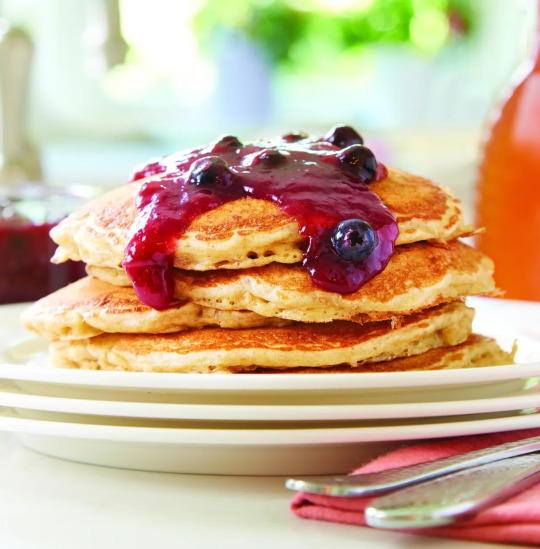
The author’s dad requested this recipe for Oatmeal Bed and Breakfast Pancakes from one where he stayed. (Photo by Kevin Scott Ramos)
Oatmeal B&B Pancakes
The headnote says: “This recipe was given to me by my dad, the chief pancake maker in our house, where pancakes were a Saturday morning ritual. He first tasted them at a bed and breakfast in Vancouver, Canada, where he asked for the recipe. This is my slightly adapted version.”
Makes 12 pancakes
Ingredients:
1 cup old-fashioned oats
1 cup whole-wheat flour
2 tablespoons sugar
1 teaspoon baking soda
1 teaspoon baking powder
1 teaspoon salt
3 tablespoons butter, chilled
2 cups buttermilk
2 eggs
2 teaspoons vanilla extract
Vegetable oil
3 cups blueberries, divided
1 cup maple syrup
Directions:
In the bowl of a food processor with a metal blade, process oats 45 seconds. Add flour, sugar, baking soda, baking powder and salt; pulse to combine. Sprinkle cold butter pieces on top, and process until mixture forms coarse crumbs. Transfer to a large bowl; make a well in center of mixture.
In a large glass measuring cup, whisk buttermilk, eggs and vanilla to combine. Pour buttermilk mixture into well of flour mixture and gently combine. (A few lumps are desired.)
Brush a large nonstick griddle or skillet with oil; bring to medium-high heat. Pour ¼ cup batter onto griddle for each pancake; cook until top is bubbly, and edges are slightly dry, about 2 to 3 minutes on each side.
Meanwhile, cook 1½ cups blueberries with maple syrup in a small saucepan over medium heat for 2 minutes. Mash cooked blueberries and strain syrup. Stir in remaining 1½ cups whole blueberries. Serve warm over pancakes.

Maple Syrup-Glazed Bacon is a sweet-salt-fat combination that takes beloved bacon to greater heights. It makes a fun garnish for a Bloody Mary. (Photo by Kevin Scott Ramos)
Maple Syrup-Glazed Bacon
The headnote says: “This sweet-salt-fat combination takes beloved bacon to greater heights. The neat and tasty technique makes bacon a stand-alone buffet item or a fun garnish for a Bloody Mary.”
Makes 12 pieces
Ingredients:
1 pound thick-sliced bacon
3 tablespoons maple syrup
Directions:
Heat oven to 350 degrees. Line a heavy rimmed half-sheet pan or jelly roll pan with aluminum foil.
Spread bacon flat on prepared pan. Bake 20 minutes. Remove cooked bacon to paper towels; discard bacon grease from baking sheet. Place an oven-safe cooling rack on baking pan. Place cooked bacon on rack, and brush one side lightly with maple syrup. Bake 10 minutes or until syrup has caramelized and bacon is cooked to desired crispness.
.

Best Maple Banana Bread is a great way to use overripe bananas that many of us keep in our freezers. (Photo by Kevin Scott Ramos)
Best Maple Banana Bread
The headnote says: “This moist banana bread started as a recipe submitted to the Chicago Tribune. It has evolved over the years, and I have added a delicious maple glaze to make it even better. This is a great use for those overripe bananas that many of us keep in our freezers!”
Makes 6 mini-loaves or 2 (9-by 5-inch) loaves
Ingredients:
Bread:
3½ cups plus 1 tablespoon
All-purpose flour, divided
2 teaspoons baking soda
2 teaspoons baking powder
1 teaspoon ground cinnamon
2 cups chopped walnuts or pecans
2 cups light brown sugar, firmly packed
4 large eggs
1¼ cups canola oil
1 (8-ounce) container sour cream
1 tablespoon maple extract
3 cups (about 8 large) very ripe
Bananas, mashed with a fork
Glaze:
¼ cup butter
½ cup maple syrup
½ teaspoon maple extract
1 cup powdered sugar, sifted
Directions:
Preheat oven to 350 degrees. Lightly grease 2 (9-by 5-inch) loaf pans or 6 mini-loaf pans; line with parchment or wax paper.
To make bread, whisk together 3½ cups flour, baking soda, baking powder and cinnamon in a large bowl. In a medium bowl, toss nuts in the remaining 1 tablespoon flour.
Place brown sugar in the bowl of a stand-up electric mixer; add eggs, one at a time, mixing on slow speed until combined. With mixer running, add oil. Add sour cream and 1 table-spoon maple extract, mixing until combined.
Add half flour mixture to brown sugar mixture; stir in mashed bananas. Stir in remaining half flour mixture and flour-coated nuts. Pour batter into prepared pans, filling ¾ full; smooth tops.
Bake 70 to 80 minutes (less for small pans) until bread rises and a toothpick inserted in center comes out clean. Cool.
To make glaze, melt butter in a small pan over medium heat; stir in maple syrup. Stir while boiling for 2 minutes. Remove from heat; stir in ½ teaspoon maple extract. Add powdered sugar; whisk until smooth. Stir 3 to 5 minutes or until mixture begins to thicken and cool slightly. Drizzle over bread.
Maple-Teriyaki Marinade
The headnote says: “This marinade helps to tenderize meat, while giving it a sweet-salty onion flavor. It works nicely with skirt steak as well.”
Makes 1¼ cups
Ingredients:
1 tablespoon garlic
1 tablespoon fresh ginger
2 tablespoons minced shallots
½ cup tamari/soy sauce
½ cup maple syrup
2 tablespoons canola oil
2 tablespoons sesame seeds
1½ pounds flank steak
Directions:
In the bowl of a food processor with a metal blade, process garlic, ginger, and shallots until minced. Add soy sauce and maple syrup; pulse to combine. Slowly add oil, and process until emulsified. Add sesame seeds, and pulse once.
Transfer marinade mixture to a shallow glass baking dish or a zip-top plastic bag. Add steak and allow it to marinate for at least 30 minutes or up to 2 hours.
Heat grill or broiler to medium high. Grill or broil, 3 to 6 minutes on each side, or until tender and internal temperature reaches 135 degrees. Let steak rest 10 minutes; slice thinly against the grain before serving.
Recipes copyright by Corrine Kozlak and used with permission of Adventure Publications.
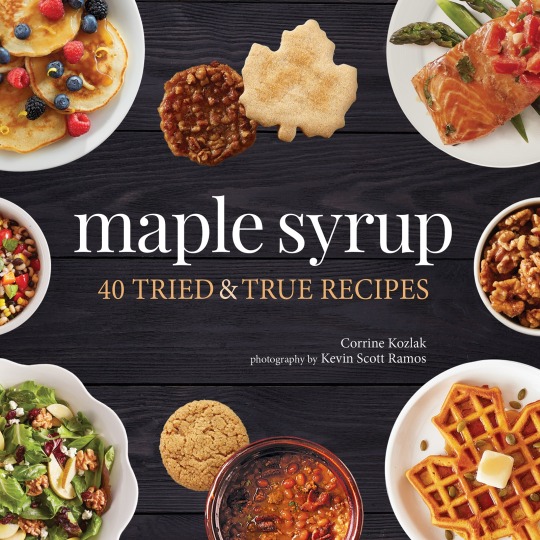
Stephen Fries is professor emeritus and former coordinator of the Hospitality Management Programs at Gateway Community College in New Haven, Conn. He has been a food and culinary travel columnist for the past 16 years and is co-founder of and host of “Worth Tasting,” a culinary walking tour of downtown New Haven. He is a board member of the International Association of Culinary Professionals. Email him at [email protected]. For more, go to stephenfries.com.
1 note
·
View note
Text
Cookbook features recipes for two-ingredient dough that anyone can make
When it comes to baking, making a pie crust and recipes requiring yeast intimidate many people, including me. Let’s be honest, at least perception-wise, baking with yeast is more complex and sophisticated than baking methods that are quicker.
But why? Activating the yeast properly could be intricate, and the rising process requires time and patience. And without the exact measuring of ingredients and timing of when ingredients are added, you could end up with not-so-appealing results. Let’s not forget accurate baking time and having a properly calibrated oven.
When it comes to a recipe that lists yeast as an ingredient, many pass right by it. The chemistry behind baking, and the preciseness required for the chemical reactions that must occur to end up with a product that has the right texture and flavor, scares home cooks. This is usually not the case when it comes to other cooking techniques.
During my interview with author Erin Renouf Mylroie for my recent soup column, she mentioned her previous title, “2-ingredient Miracle Dough Cookbook: Easy Lower-Carb Recipes for Flatbreads, Bagels, Deserts and More” (2019, Page Street Publishing, $21.99). I was determined to get a copy.
She was originally skeptical when she came across two-ingredient dough while browsing online. Considering herself to be an avid baker, and not minding the hours to produce aged pizza dough to perfection, and other quality baked goods, she said: “The idea of a dough that could be ready in minutes with only two ingredients seemed almost like fool’s gold … and probably too good to be true.”
After trying a few recipes, she was sold on this new technique of baking.
“Anyone who can hold a spoon can make two-ingredient dough,” she writes. “Everyone can remember the ingredient list: equal parts Greek yogurt and self-rising flour. There’s no waiting, no rising, no complicated or fussy techniques here.”
Another plus she mentions is this dough is lower in calories and carbs. Why?
“Half of the bulk of the dough comes from protein-rich Greek yogurt,” she said. “You’ll always want to use Greek yogurt for two ingredient dough because of its thick texture. Regular yogurt will be too watery to get the thick and only slightly sticky dough. Greek yogurt is also a better source of protein than regular yogurt, so you’ll get more health benefit from this type.”
When asked about using this technique and the difference in the outcome vs. using yeast, she responded: “The leaveners in the self-rising flour react with the yogurt in the dough to create a light and fluffy baked good. It’s not exactly the flavor of yeast, but it gets the job of done with fantastic results!”
I asked her to pick her two favorite recipes from the book.
“I really love the bagels in the book,” she said. “It was the first two-ingredient recipe I tried, and the one that I return to must often. They make an excellent breakfast sandwich in the morning, a great snack with a schmear of protein, and they slice up nicely to make bagel chips if you’re blessed with any leftovers.
“I also love buttery parmesan and garlic knots. It’s hard not to love anything slathered with garlic butter. One of the sweet treats that I love is the Ginger and Brown Sugar banana cake. It’s a bit of a stretch to call it two- ingredient dough since I throw in a few more things, but it sure is scrumptious!”
What does she hope the reader learns from the book?
“I hope that readers of ‘2-Ingredient Miracle Dough’ will enjoy creating baked goods that are a little healthier, a little faster and a little easier than yeast risen baked goods you would normally make at home,” she said. “I hope it gets some readers back in the kitchen!”
She concludes the book’s introduction with, “Two-ingredient dough might seem a little too good to be true, but that’s the miracle.”
For the recipe for Four Seasons Sheet Pan Pizza—Pizza Quattro Stagioni visit https://bit.ly/4c2u0nY
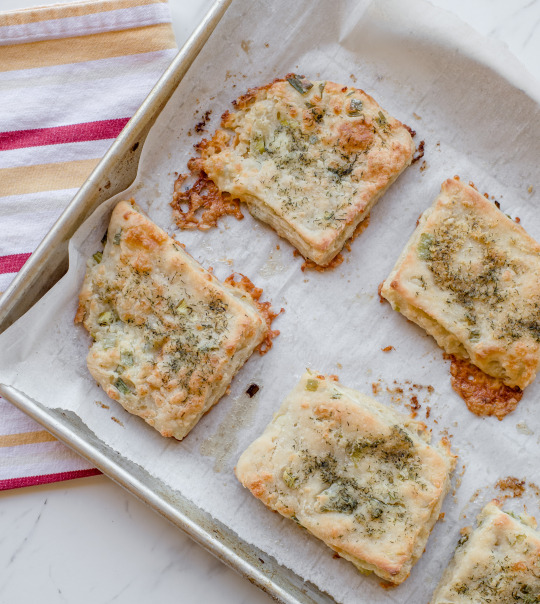
Monterey Jack Cheese, Dill and Scallion Biscuits
The headnotes says: “I love biscuits with barbecue in the summertime and with pot roasts in the winter. Biscuits come together so quickly, but like all warm breads, they make a meal seem almost holiday-special. If you have any leftover biscuits, these make a spectacular sandwich with leftover shredded barbecue meat and a little coleslaw.”
Makes 6 biscuits
Ingredients:
1½ cups self-rising flour, plus more for work surface
1½ cups plain Greek yogurt
3 tablespoons cold butter
½ cup Monterey Jack cheese, shredded
¼ cup sliced scallions
2 tablespoons butter, melted
½ teaspoon garlic powder
1 teaspoon dried dill weed
Directions:
Preheat the oven to 425 degrees and line a baking sheet with parchment paper.
In a medium bowl, mix the flour and yogurt until just combined. Grate the cold butter, using the large holes from a box grater, directly into the bowl with the flour and yogurt. Gently stir together. Stir in the shredded cheese and scallions.
Dust a work surface generously with flour. Transfer the dough to the work surface and knead until smooth, about 30 seconds. Press the dough into a rectangle, about 9 x 6 inches. Using a sharp knife, cut the dough into six equal-shaped square biscuits. Transfer the biscuits to the baking sheet, spacing about 2 inches apart.
In a small bowl, combine the melted butter, garlic powder and dill. Brush about half of the butter mixture over the tops of the biscuits. Bake for about 16 minutes, or until they are golden brown. Remove the biscuits from the oven and brush them with the remaining butter mixture. Cool for 5 minutes before eating.

Philadelphia Cheesesteak Strombolipays homage to the two great Philadelphia food favorites: cheesesteak and stromboli. (Courtes of Ken Goodman)
Philadelphia Cheesesteak Stromboli
The headnote says: “This hearty dish pays homage to the two great Philadelphia food favorites: cheesesteak and Stromboli. The debate rages on over what is the proper cheese for a Philly cheesesteak, but I prefer provolone here because it melts beautifully and adds a hint of creamy sweetness. You could swap out the provolone for any cheese you like. One more note: this Stromboli is a Superbowl tradition at my house. Cut it small if you want to serve it as an appetizer.”
Serves 6
Ingredients:
1 tablespoon vegetable oil
1 pound tender beef sandwich steaks, raw, thinly sliced
1 green bell pepper, thinly sliced
1 onion, thinly sliced
6 ounces mushrooms, thinly sliced
1 tablespoon Worcestershire sauce
1¼ cups self-rising flour, plus more for work surface
1¼ cups plain Greek yogurt
8 ounces provolone cheese, sliced, or substitute shredded mozzarella
2 tablespoons butter
1 clove garlic, minced
1 tablespoon minced parsley
Directions:
Heat the oil in a large skillet over medium-high heat. Add the beef and cook about halfway through, about 3 minutes. Add the bell pepper, onion and mushrooms. Cook for about 7 minutes, or until the meat is cooked through and the vegetables are softened. Add the Worcestershire sauce and stir. Turn off the heat and let it cool slightly.
Preheat the oven to 425 degrees and line a standard baking sheet with parchment paper.
In a medium bowl, combine the flour and yogurt with a wooden spoon, stirring until a sticky dough forms. Generously flour a work surface. Turn dough out onto the work surface and knead, adding a dusting of flour from time to time, until the dough is no longer sticky. Roll or press the dough into a rectangle about 15 x 10 inches. Place the cheese in a long line parallel to the long edge of the dough, leaving a 4-inch margin. Cover the cheese with the beef mixture.
Roll up the dough, cinnamon roll style, until you have a tight cylinder, and pinch the edges shut. Transfer the Stromboli to the prepared baking sheet.
In a small microwaveable dish, heat the butter and garlic until the butter is melted and the garlic is fragrant, about 40 seconds. Add the parsley. Brush the dough with half the butter and garlic mixture. Cut a few slits along the top of the dough to allow steam to escape.
Bake the Stromboli for 14 to 18 minutes, or until it’s golden brown. Brush the Stromboli with the remaining butter mixture. Let it cool for 10 minutes before slicing into segments and serving.
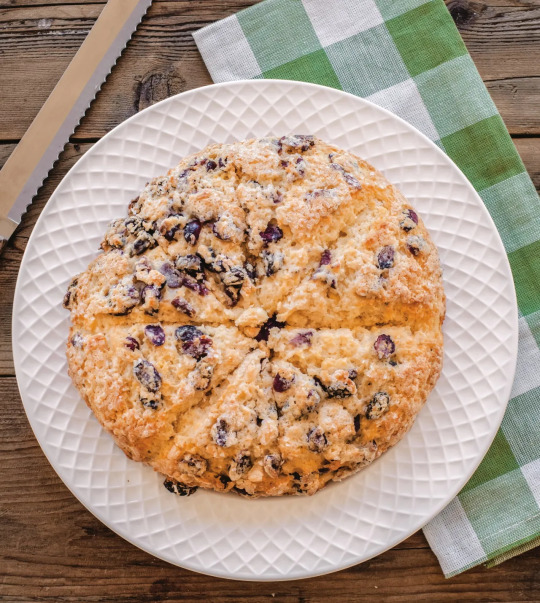
Sweet Irish Soda Bread with Currants and Raisins is perfect for St. Patrick’s Day. Serve it warm with a generous dollop of creamy Irish butter. You can add caraway seeds if you like for an interesting sweet and savory twist, (Courtesy of Ken Goodman)
Sweet Irish Soda Bread With Currants and Raisins
The headnote says: “I’m duty bound to make this special bread for St. Patrick’s Day every year, but it would be wonderful any day, especially if you serve it warm with a generous dollop of creamy Irish butter. You can add caraway seeds if you like for an interesting sweet and savory twist, but I like it best with dried fruit and a crunchy sugar topping. “
Serves 8
Ingredients:
½ cup dried currants or dried cranberries
¼ cup raisins
1½ cups self-rising flour, plus more for work surface
1 cup vanilla-flavored Greek yogurt
4 tablespoons sugar
1 egg
2 tablespoons cold butter, grated
2 tablespoons cream or milk
2 tablespoons turbinado or coarse sugar
Directions:
Place the currants and raisins in a small dish and cover with 1 cup boiling water. Set aside for 10 minutes.
Meanwhile, line a baking sheet with parchment paper and preheat the oven to 425 degrees.
In a medium bowl, combine the flour, yogurt, sugar, egg and butter. Drain the currants and raisins and stir them into the dough.
Generously flour a work surface. Turn out the dough onto the work surface. Knead the dough until a smooth dough forms, about 1 minute. Place the dough on the prepared baking sheet and brush with the cream and sprinkle with the turbinado.
Using a sharp knife, score the bread into eight pieces, cutting pie style into wedges, but not cutting all the way through to the bottom. Bake for 22 to 24 minutes, or until it’s golden brown. Serve in wedges with whipped butter if you like.
Recipes reprinted with permission from “2-Ingredient Miracle Dough Cookbook” by Erin Renouf Mylroie (Page Street Publishing Co., 2019)
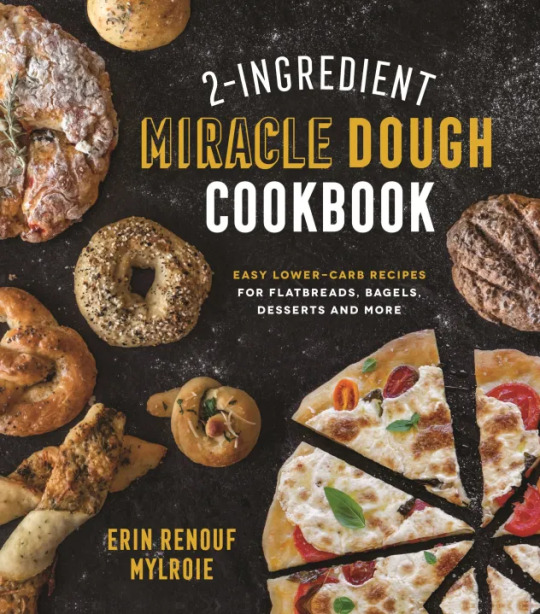
Stephen Fries is professor emeritus and former coordinator of the Hospitality Management Programs at Gateway Community College in New Haven, Conn. He has been a food and culinary travel columnist for the past 16 years and is co-founder of and host of “Worth Tasting,” a culinary walking tour of downtown New Haven. He is a board member of the International Association of Culinary Professionals. Email him at [email protected]. For more, go to stephenfries.com.
0 notes
Text
A weekend of Food, Fun & Friends on Amelia Island, FL


We had so much success with our culinary weekend in 2023 we are doing it again! Stephen Fries and Chris Bartlett will host “Worth Tasting” the weekend of October 18 – 21, 2024 at The Addison on Amelia Island!
This is an all-inclusive culinary weekend creating food boards, holiday boards, farmers market tour, downtown Fernandina Beach walking tour with sips and small bites at select locations, cookbook market at a local bookstore, and unique dining experiences at two of Fernandina Beach’s fabulous restaurants.
Spend the weekend in historic downtown Fernandina Beach, FL on Amelia Island learning the secrets of
creating food boards to enjoy at the inn as well as ideas to take home to share and prepare for family and friends.
The culinary weekend includes a 3-course breakfast each morning at the inn, lunch on Saturday and Sunday, an evening social hour with complimentary beverages Friday, Saturday, and Sunday at the inn, and dinners Friday night and Sunday nights at a local brewery and Sunday night
at one of our partner restaurants.
$895 Per Person Plus Room – Requires a 3-Night Stay
Please book at addisononamelia.com and enter the promo code Worth Tasting
or call us at 904-277-1604 to make your reservation.
Itinerary subject to change
0 notes
Text
Worth Tasting Culinary Tours
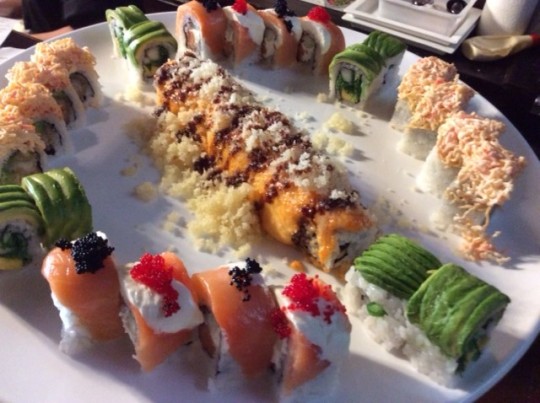
Hello!
We hope you are doing well and looking forward to some fun things to do this year. Spring is in the air!
We are delighted to announce the dates for the 2024 “Worth Tasting” culinary walking tour of downtown New Haven. As a past participant, you are the first to know the dates, prior to the media.. As you know, the tours fill up fast, so please purchase your tickets very soon. Please go to the link for the date(s) you are interested in. The first link is my website link that takes you to the Eventbrite site (it might not be updated for a couple of days). The second link will take you directly to Eventbrite where tickets can be purchased now. The May date will show and scroll down for the other dates. Any questions, please call 203-415-3519.
A culinary tour is a great way to celebrate a birthday or other special occasion with family and friends.
May 4 June 8 September 14 November 2 December 7 (holiday tour)
.https://stephenfries.com/culinary-tours
Please "like" Worth Tasting on Facebook.
We look forward to welcoming you…..
P.S. Look out for information about 3 day Worth Tasting culinary adventures in Amelia Island, Florida, New Smyrna Beach, Florida and at the famous Sagamore resort on Lake George in NY!
Stephen & Chris
http://www.stephenfries.com
0 notes
Text
Dish up some comfort

Recipes and images courtesy of Julia Rutland, author
As seen in https://www.mainlinemedianews.com/2024/02/25/dish-up-some-comfort/
Is it the taste, nostalgia, mood or being lonely that causes one to resort to eating comfort food?
Whether it be high-fat, sugar, carbs or salt, at certain times we crave eating homestyle foods. As I write this column, it is a cold, gray and blustery day. Easy to prepare, although not exactly gourmet, this category of food we’ve come to savor comes to the rescue.
Creamy mashed potatoes with spinach fit the bill for me on this bleak day. It’s a dish Mom and Grandma served frequently.
Depending upon the region or country you are from, what one considers comfort food varies. Brazil’s feijoada, French onion soup, Greece’s moussaka, Irish stew, Italy’s lasagna, Poland’s pierogi, United Kingdom’s fish and chips and the United States’ macaroni and cheese are the tip of the iceberg when it comes to this type of connection to our food.
According to an article in The Atlantic, “The phrase ‘comfort food’ has been around at least as early as 1966, when the Palm Beach Post used it in a story…”
A feature by Bert Gambini in a University of Buffalo newsletter says: “Regardless of what you identify as comfort food, it’s likely the attraction to that dish is based on having a good relationship with the person with whom you remember first preparing it…. Comfort foods are often the foods that our caregivers gave us when we were children.”
“If we have a positive association with the person who made that food, then there’s a good chance that you will be drawn to that food during times of rejection or isolation,” says University of Buffalo psychologist Shira Gabriel.
The top five comfort foods listed in Discover Magazine (https://bit.ly/3uuiQI3) are grilled cheese, mac and cheese, mashed potatoes, pizza, spaghetti and meatballs.
It goes on to say, “Ralph’s Italian Restaurant (oldest Italian restaurant in the U.S.) in South Philadelphia is recognized as having the best meatballs in the U.S.”
Check out this link, bit.ly/3OOgudJ, for a video of them being prepared.
There are myriad books devoted to comfort food and homestyle cooking. So many of these recipes celebrate American cuisine, countless handed down through the generations.
Julia Rutland, author of a book that will be available on April 16 titled “Homestyle Kitchen: Fresh & Timeless Comfort Food for Sharing” (2024, Adventure Publications, $22.99) said: “Homestyle cooking creates the type of food that embodies the warmth and familiarity of a loving home. While family and cultures differ, homestyle cooking relies on fresh ingredients, traditions, generational recipes, and comfort.”
Rutland’s hope is to inspire memories. Many of the recipes featured are from her mom’s recipe box with her own twist on them. The recipe for Wacky Cake, she mentioned, is the first recipe she ever made when she was a child. Making this cake today preserves not only the flavors but also the memories of shared meals around the table; emotionally comforting.
During an interview, Rutland used a food term I was not familiar with: “meat ‘n’ three.” Do you know what it is? Well, if you are from the South, you might. It’s a way Southern comfort food is served in many restaurants… you choose a meat (often it is meatloaf, fried chicken, country- fried steak) plus three sides from the menu.
Guess what some of the side selections might be? Mac n’ cheese, collard greens, hush puppies. My mouth is watering thinking about the meals I enjoyed in the South.
Comfort food and homestyle cooking don’t seem to be falling out of popularity. Let’s get cooking a few recipes from Rutland’s book, food that is approachable, food we cherish that brings back fond memories. One of these may be or become a dish you savor. For the recipe for Parker House Rolls, visit https://stephenfries.com/recipes.
Even with warmer weather around the corner, I’ll still be eating mashed potatoes and spinach when I crave comfort food.
Here are come recipes from Rutland’s upcoming book.

Baked Four- Cheese Macaroni: This crispy-topped and creamy-centered macaroni and cheese features four cheeses that take the company-size side dish to the next level. (Courtesy of Julia Rutland)
Baked Four-Cheese Macaroni
The headnote says: “This crispy-topped and creamy-centered macaroni and cheese features four cheeses that take the company-size side dish to the next level. Use a variety of your favorite cheeses — smoked Gouda is lovely! Grate from large pieces rather than buying packaged shredded cheese because those contain starches that keep them from clumping and melting well. It’s okay to skip the topping and eat the dish before baking, but you’ll miss the golden-brown crust. Instead of panko, feel free to try cheese crackers as a variation.”
Serves 8-10
Ingredients:
2 cups (8 ounces) shredded sharp cheddar cheese
1 cup (4 ounces) shredded Gouda, provolone or Monterey Jack cheese
½ cup (2 ounces) shredded Parmesan cheese
½ cup salted butter
¼ cup all-purpose flour
½ teaspoon salt
½ teaspoon coarsely ground black pepper
½ teaspoon garlic powder
1/4 teaspoon cayenne pepper
2 cups vegetable or chicken broth
2 cups milk or half-and-half
1 (8-ounce) package cream cheese, cut into pieces
1 (16-ounce) package macaroni, penne, or other short pasta
1/3 cup panko breadcrumbs
Directions:
Preheat oven to 350 degrees. Lightly grease (with butter) a 9-by-13-inch (3-quart) baking dish. Toss cheddar, Gouda, and Parmesan together in a small bowl. Reserve ½ cup shredded cheese mixture.
Melt butter in a large skillet or saucepan. Whisk in flour, salt, black pepper, garlic powder, and cayenne pepper. Cook, whisking constantly, for about 1 to 2 minutes. Whisk in broth and milk until smooth. Cook, whisking constantly, for 5 minutes or until thickened. Stir in cream cheese; cook until smooth. Stir in all but reserved 1/2 cup shredded cheese mixture; cook, stirring frequently, until smooth.
Cook pasta according to package directions; drain and transfer to prepared baking dish.
Pour sauce over pasta, stirring until well blended. Stir panko into reserved ½ cup cheese mixture; sprinkle over pasta mixture. Bake, uncovered, for 25 to 30 minutes or until golden brown.
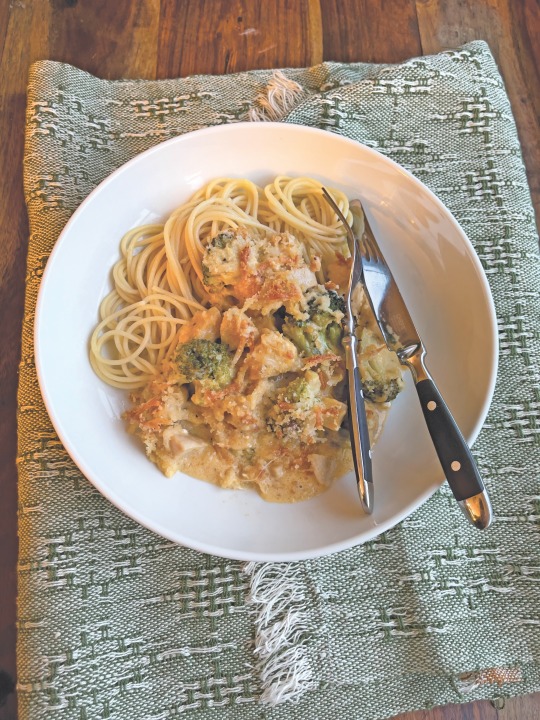
This Chicken Divan’s origin is said to come from the Divan Parisien Restaurant at the Chatham Hotel in New York City sometime in the 1930s or 1940s. While many recipes use canned-soup shortcuts, this one is closer to the original with a homemade bechamel sauce. (Courtesy of Julia Rutland)
Chicken Divan Casserole
The headnote says: “This dish makes a comforting meal with or without a side of buttered noodles or hot cooked rice. Its origin is said to come from the Divan Parisien Restaurant at the Chatham Hotel in New York City sometime in the 1930s or 1940s, but it wasn’t likely served in a casserole form. It became wildly popular in households in the 1950s; while many recipes use canned-soup shortcuts, this one is closer to the original with a homemade béchamel sauce.”
Serves 6-8
Ingredients:
6 cups broccoli florets (about ¾ pound)
2 pounds boneless, skinless chicken breasts, cut into bite-size pieces
1 teaspoon fine sea salt, divided
¾ teaspoon coarsely ground black pepper
5 tablespoons salted or unsalted butter, divided
3 tablespoons all-purpose flour
2 cups chicken broth or Quick Chicken Broth (on page 44)
1 cup half-and-half or whole milk
2 cups (8 ounces) shredded cheddar cheese
1 teaspoon Worcestershire sauce
1/8 teaspoon cayenne pepper
½ cup sour cream
Cheesy Topping (recipe below)
Hot cooked pasta or rice (optional)
Directions:
Lightly grease (with butter) bottom and sides of a 9-by-13-inch (3-quart) baking dish.
Cook broccoli in boiling water to cover for 5 minutes or until crisp-tender. (You can also place broccoli in a microwave-safe bowl with ¼ cup water. Cover and microwave on high for 3 ½ minutes.) Drain and transfer to prepared baking dish.
Sprinkle chicken with ½ teaspoon salt and ¼ teaspoon black pepper. Melt 2 tablespoons butter in a skillet over medium-high heat. Add chicken in batches and cook, stirring occasionally, for 5 minutes or until browned on all sides. Transfer to baking dish.
Preheat oven to 375 degrees.
Melt remaining 3 tablespoons butter in the same skillet (no need to wipe clean) over medium heat. Add flour and cook, stirring constantly, for 1 minute. Slowly whisk in broth and half-and-half. Cook, stirring frequently, for 2 minutes or until slightly thickened. Stir in cheese, Worcestershire, cayenne pepper, remaining ½ teaspoon salt, and remaining ½ teaspoon black pepper. Stir in sour cream. Pour sauce over chicken and broccoli.
Sprinkle Cheesy Topping evenly on top. Bake, uncovered, for 25 to 30 minutes or until golden brown and bubbly. Serve over hot cooked pasta or rice, if desired.
Cheesy Topping: Combine ½ cup shredded Parmesan or cheddar cheese, ½ cup panko or fine breadcrumbs, and 2 tablespoons melted salted or unsalted butter in a bowl. Makes ¾ cup.
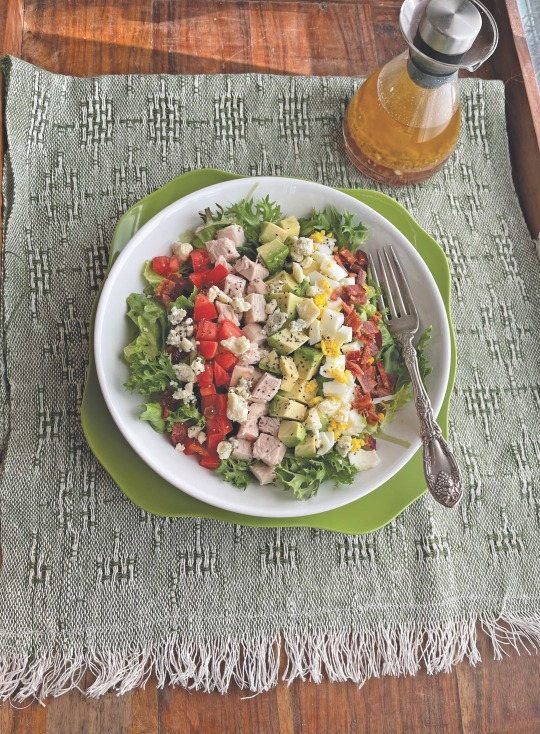
Originally made famous at Hollywood’s Brown Derby Restaurant, this Cobb Salad has changed little over the years. (Courtesy of Julia Rutland)
Cobb Salad
The headnote says: “Originally made famous at Hollywood’s Brown Derby Restaurant, this salad has changed little over the years. In 1937, owner Bob Cobb explored the kitchen one night in search of a snack. He pulled out various ingredients from the refrigerator and created a hearty salad that he shared with his friend Sid Grauman of Grauman’s Chinese Theatre. Grauman returned the next day and asked for a ‘Cobb salad.’ The Cobb salad is a favorite on menus today. Off season, endive and watercress might be tricky to find in markets. Substitute easily found spring salad mix instead.”
Serves 4
Ingredients:
1 small head Romaine lettuce, chopped
½ head iceberg lettuce, chopped
1 small bunch curly endive, chopped
½ bunch watercress
2 tablespoons minced fresh chives
2 tomatoes, peeled and diced
2 cups diced cooked chicken breasts
6 bacon strips, cooked and chopped
3 hard-cooked eggs, diced
1 ripe avocado, diced
½ cup crumbled Roquefort or blue cheese
French Vinaigrette Dressing (recipe below)
Directions:
Combine Romaine, iceberg, endive, watercress and chives in a large salad bowl, mixing well. Place on a serving platter or on individual salad plates. Arrange tomatoes, chicken, bacon, eggs, and avocado in strips across salad greens. Sprinkle with cheese. Drizzle with French Vinaigrette Dressing.
French Vinaigrette Dressing: Combine ¼ cup water, ¾ teaspoon dry mustard, 1 teaspoon salt, ½ teaspoon coarsely ground black pepper, 1/4 teaspoon granulated sugar, ¼ cup red wine vinegar, 1 ½ teaspoons lemon juice, ½ teaspoon Worcestershire sauce, and 1 minced garlic clove in a bowl. Whisk in 3/4 cup vegetable oil and 1/4 cup extra-virgin olive oil. Blend well just before serving. Store in refrigerator up to 2 weeks. Makes 1 ½ cups.

Named for their creation in the 1870s at the Parker House hotel in Boston, these rolls differ from regular yeast rolls in that they are folded into layers, brushed with butter and baked close together. (Courtesy of Julia Rutland)
To see the recipe for Parker House Rolls, visit https://stephenfries.com/recipes.
Stephen Fries is professor emeritus and former coordinator of the Hospitality Management Programs at Gateway Community College in New Haven, Conn. He has been a food and culinary travel columnist for the past 16 years and is co-founder of and host of “Worth Tasting,” a culinary walking tour of downtown New Haven. He is a board member of the International Association of Culinary Professionals. Email him at [email protected]. For more, go to stephenfries.com.
0 notes
Text
New Smyrna Beach in Florida is an idyllic haven
Check out my latest column
From surfers with a taste to catch a great wave to early morning sunrise photographers and beach walkers, anywhere along 17 miles of inviting, white sand beaches, New Smyrna Beach, Fla., is an idyllic haven to stay in and feel a bit like a local while savoring an incredible vacation.
The sunshine and air feel and seem brighter and lighter in this historic charmer of a beach town. You can even drive and park your car directly on the beach — one of very few places in Florida and the Continental U.S. where this unique, off-road experience is allowed.
It feels like it all happens here between the rich biodiversity of the Indian River Lagoon and its important place in Florida’s history of its earliest settlers with the arrival of a Scottish physician and about 1,200 Mediterranean settlers in 1768. New Smyrna Beach is named after the wife of Andrew Turnbull, who was born in Smyrna in Asia Minor.
Arriving to visit some 256 years later in January marked a turning point in our dozens and dozens of trips to Florida. Something here struck me as the best of everything Florida has to offer all rolled into the fascinating facets, districts and avenues that create an ideal location for diverse culinary exploration. A foodies playground for sure . . . Truly, one of Florida’s hidden gems.
I couldn’t agree more with how the visitor’s bureau (www.visitnsbfl.com) describes the area’s lodging options: “In New Smyrna Beach, there are as many different styles of lodging as there are varieties of birds skimming the shores. From whimsically appointed, colorful and eclectic, low-slung beach cottages just steps from the sand, to lofty, sleek, bright, modern oceanfront condos with picture windows overlooking the shimmering ocean horizon.”

The Black Dolphin Inn an intimate, Spanish Isle-inspired enclave with 14 rooms, is situated across from the Indian River (Courtesy of Jumping Rocks Inc. and provided by Black Dolphin Inn)
The Black Dolphin Inn (www.blackdolphininn.com), an intimate, Spanish Isle-inspired enclave with 14 rooms, is situated across from the Indian River, where relishing watching the sun rise was the perfect way to begin the day. I could tell that lots of love went into the design of this spectacular inn. From the moment we first saw the architecture and lobby, we knew this was someplace special.
The focal point upon entering is the immaculate, open kitchen and counter seating, where a full breakfast is served daily. I asked the owner what the inspiration for the kitchen’s location was.
“The kitchen is where we convene in the home and as part of the design, it was important to make it conducive for us to interact with the guests,” he said.
This AAA Four Diamond inn has uniquely decorated rooms, many with a balcony, where one can enjoy morning coffee or sip a glass of wine. The courtyard with its cypress and palm trees is an oasis to sit and relax with a book or think about what is next on the agenda in exploring.

Joy By The Sea is a tranquil, luxe, seaside oasis. (Photo courtesy of Joy By The Sea)
Wanting to experience a beachside location, Joy By The Sea (https://joybythesea.org) more than fulfilled this desire. Six beachside villas include two 1-bedroom (perfect for families) and four studios. All are complete with a full kitchen, surrounding the saltwater pool — a tranquil, luxe, seaside enclave.
The lavish and comfortably adorned Beach House across the street is the crème de la crème when it comes to a true-getaway vacation. With four bedrooms, full kitchen, two giant balconies, large pool with volleyball net, hot tub, outdoor kitchen and beachfront location, it’s a perfect place for large families and reunions.
And to top it all off, The Queen’s Gambit, about a mile away, is for those who want to experience a lavish beachfront lifestyle. The 5,000-square-foot home (sleeps 10) is immaculately decorated, has four bedrooms, an oceanfront, outdoor kitchen with pizza oven, infinity pool, putting green and pool table. No matter which accommodation you choose, Ryan, the concierge will arrange the perfect vacation or party with every amenity imaginable.

Funghi Fromage pizza at Third Wave Cafe & Wine Bar
Third Wave Café & Wine Bar serves a classic yet eclectic mix of traditional Mediterranean and Southern coastal cuisine. Chef Dave focuses on using locally sourced and sustainable ingredients. He mentioned that the chicken comes from a few miles down the road. Mozzarella is made in house. And double zero flour (a must-try) is used to make pizzas. Think artisan restaurant in a beach town. The patio is inviting, adorned with greenery and enchanting firepit featuring an artistic iron globe sculpted into an octopus-sphere.
From the freshest of seafood, rotating features from the smoker to Neapolitan pizza, the price points meet all budgets. The Christmas salad is so colorful with vibrant flavors (shredded Granny Smith apples, carrots, cabbage, cucumber, roasted beets, kale, candied pecans, ricotta, white balsamic vinaigrette).
Knowing that the chef uses double zero flour, we had to order the Funghi Fromage pizza (oak-roasted, seasonal mushrooms, shredded mozzarella/provolone, Parmigiano Reggiano, garlic, herbs, authentic black truffle oil). It met our high expectation being that we are spoiled by some of the best pizza in the world in our hometown of New Haven, Conn.
Wild Alaskan King Salmon from the chef’s private reserve is brined, peppercorn crusted with Dijon butter beurre Blanc, an amazing dish. Keeping with the seafood theme, the description of Creste de Gallo caught my attention: broken scallops, Florida rock shrimp, semolina pasta, mushrooms, artichokes, cherry tomatoes, capers, tossed in scampi butter and topped with a sprinkle of Pecorino. It tasted as good as it sounded with a generous amount of seafood.
The mixologist serves up creative beverages, including the “Dry Creations.” The Queen’s Mule was impressive in both taste and presentation, prepared with Seedlip distilled herbal (a non-alcohol spirit), house-made hibiscus honey syrup, organic lemon, mint and Fever Tree ginger beer. The luscious tres leches cake is large enough for two, perhaps even three, beautifully adorned with piped fresh whipped cream topped with strawberries.
SoNapa Grille pays homage to two popular wine regions in California, Sonoma County and Napa Valley, with its extensive wine list and chef-inspired food complementing the wine. Whether you’re looking for a full entrée or light bites, the menu has you covered. Popular on the menu are the brick oven flat breads, so one had to be tried. The Sereno de Mar (grilled shrimp, sun-dried tomato pesto, spinach, goat cheese crumbles, with a drizzle of balsamic glaze) was lite and flavorful. The perfectly executed thin crust, cooked to perfection let the toppings take center stage.
The soup special, Green Bean “casserole” is a play on a Thanksgiving traditional side dish, tasting like it, albeit with soup consistency. The grilled shrimp and polenta description led to ordering this appetizer. Large shrimp tops a crispy polenta cake with just enough habanero honey butter to add a bit of heat and sweet, all sprinkled with goat cheese crumbles. Tile fish (always try local) was the catch of the day. The mild, sweet flavor is similar to lobster and crab. Its preparation allows the fine flavors to shine; pan seared, served over dashi-infused, black-forbidden rice, topped with shitake-umami butter sauce. The seasonal “Churro” Basque cheesecake…yes, the flavors of a churro) put a fantastic, sweet ending to the SoNapa experience.

Norwood’s Restaurant and Treehouse Bar is quite a unique setting. With the right timing, you might capture picturesque sunset views through the canopy of branches and foliage. (Photo courtesy of Chris Bartlett)
Norwood’s Restaurant & Treehouse Bar is not new to the food scene, founded in 1946, and a local favorite. What makes Norwood’s unique is the option to dine and enjoy a drink upstairs — in the tremendous treehouse. With the right timing you might capture picturesque sunset views through the canopy of branches and foliage.
But don’t let the treehouse overshadow the food. The house smoked bacon wrapped scallops is a popular dish. It’s so popular, the restaurant goes through 300 pounds of bacon per week. The zucchini bread served with whipped local honey-cinnamon butter is a must. Interestingly, Chef Dennis had an abundance of zucchini on hand when restaurants were forced to close due to the pandemic. Thus, zucchini bread was the answer. Those who ordered take-out, were given a loaf to enjoy at home.
He was pleased to provide his recipe (see below). The recipe, prepared at home, was perfect in taste and texture and it’s addicting. The smoked fish dip, perfect for sharing, is served with locally made lavash (the best ever). The seafood “potpie” has a generous amount of shrimp, scallops, crab and other fresh fish sauteed in a white wine supreme sauce topped with tender and flaky puff pastry.
Seafood lovers, you’ll want to order the Admiral’s Platter (5-ounce lobster tail, grilled mahi, broiled sea scallops and shrimp). Next visit, we’ll save room to savor the cinnamon roll cheesecake topped with a Rumchata cream cheese icing and candied pecans. If you enjoy eating early, the Sunset Menu offers great options.
Something we found quite charming in New Smyrna Beach is how it feels like there are three distinct downtown areas, each with a different vibe to experience and explore. Flagler Avenue, with its chilling-at-the-beach energy, exudes the more relaxed; aren’t-we-all-tourists-on-vacation kind of atmosphere. Our first day began both with breakfast at the super-fun, uber-themed Mermaid Cafe, and a stroll up and down Flagler to the beach and back to where the causeway bridges over the Indian River North.
The Mermaid Cafe offers a playful and innovative menu, where most of the usual breakfast fare has some unique twist or interesting preparation — think Belgian waffles stuffed with all kinds of fresh, yummy goodness. These are way beyond the typical egg, meat and cheese sandwiches. How about a gorgeous basket of piping-hot, powder-sugar covered beignets . . . So scrumptious that they rival Cafe du Monde in New Orleans.
After hanging out at the beach, exploring local shops and Smyrna Dunes Park, we headed to Avanu on Flagler for dinner. What a beautiful space. The Polynesian-leaning menu, exquisitely curated dining and bar areas, coupled with inventive dishes make this restaurant inviting and charming. From the Volcano Shrimp to the Bugagi Salad to the Lemongrass Seafood Noodles, each dish and every bite was a hit.
On this coolish evening, we chose to “experience” the Fire Dessert, which was a creamy slice of panko-crusted cheesecake, flash fried then flambeed (tableside) ala Bananas Foster -yes, outrageous and decadent and sheer perfection!
Canal Street straddles the mainland side of the Indian River North. It is lined with eclectic shops, restaurants, art studios, bars and cafes. It seems as though this is where the locals, and area residents, come into town to conduct business, shop, eat, engage and play.
The Hub on Canal and Jane’s Art Center are two of the most impressive spaces both to shop (and support) regional artists, and to immerse in some fantastic classes — super impressive spaces that add such inspiration and vibrancy to the community.
Lunch at The Corkscrew was inspired. From the superb service to the decor to the fresh menu fare, we are thrilled that we dined here. The Cuban Candy (crispy fresh cod bites with sweet chili sauce and house-made remoulade) is so tasty that we could eat it everyday. And though we passed on a sweet ending (extremely difficult to do), the dessert tray that our waiter displayed at the table was total temptation city.
Another fantastic spot along the river, and not too far from Canal Street, is Outriggers. From locally caught fish, fresh-fried or expertly grilled, Chef Erik Amalfitano’s passion for creating and serving food people will enjoy and love is refreshing and infectious. He also happens to have mastered one of the best Key Lime Pie recipes — classic and memorable (crazy-big portion, too) as it is meant to be.
Over on Third Avenue, we couldn’t resist at least one stop into Mon Delice for croissants, pastries, coffee from locally roasted beans and custom-made breakfast sandwiches with a choice of just about any type of French bread, rolls and/or croissants. Although there is nowhere to eat inside, this is a must-visit at least once, or once daily, if you love an authentic European-style bakery, this is the place.
Across Third Avenue, adjacent to both Norwood’s and The Garlic, is Heath’s Natural Foods. We enjoyed the market with its massive array of products for body, mind and spirit. From the available wine varieties to the chef-driven deli area, everything is thoughtfully and purposefully curated, prepared and shared with sheer joy — thus we enjoyed a wonderfully delicious and nutritious lunch here.
It was welcoming, friendly and authentic in a way that seems to perfectly reflect the extremely dynamic and hospitable people who give New Smyrna Beach such brightness and warmth.
Interestingly, the more days spent exploring any local, culinary destination, our list of recommendations from people only grows as to where we have to try while in town. Everyone has their respective favorites. And that’s no surprise.
Of course, New Smyrna Beach was no exception. With only four full days, these bragged about restaurants and historic inn await our return. A quick tour of the Victoria 1883 left us breathless between its exquisitely appointed interior, rooms and thoughtfully presented grounds and property — an absolute must stay.
One breakfast chef said both The Spot and The Bakers Table are musts. A few other recurring favorites seemed to be The Garlic, Limoncello, Cafe del Soul, City Market Bistro and The Grille at Riverview. Unfortunately, we didn’t make it to Island Roasters Coffee Company either, but next time awaits.
Norwood’s Zucchini Bread Recipe

Ingredients:
3 cups zucchini, julienned
1 ½ cups canola oil
6 eggs
4 cups sugar
4 ¾ cups flour
1 ½ teaspoons baking powder
1 ½ teaspoons baking soda
1 ½ teaspoons salt
1 ½ teaspoons cinnamon
1 ½ teaspoons nutmeg
1 ½ teaspoons cloves
Directions:
Preheat oven to 350 degrees. Grease a 9 x 13 inch pan.
Place zucchini, oil and eggs in the bowl of a stand mixer and mix until combined.
In a bowl, sift the remaining ingredients. Add the dry ingredients to the wet ingredients and mix until combined. Place batter in the greased pan and bake for 45-60 minutes. The top of the loaf will spring back when lightly pressed, alternatively, cake tester will be clean after inserting.
Stephen Fries is professor emeritus and former coordinator of the Hospitality Management Programs at Gateway Community College in New Haven, Conn. He has been a food and culinary travel columnist for the past 16 years and is co-founder of and host of “Worth Tasting,” a culinary walking tour of downtown New Haven. He is a board member of the International Association of Culinary Professionals. Email him at [email protected]. For more, go to stephenfries.com.
0 notes
Text
Soup is a welcome winter comfort food
It’s the time of year, at least in the Northeast, where a piping hot bowl of soup, gumbo, broth, chowder or consommé is a welcome comfort food on a cold and blustery, winter day. And don’t forget a slice of hearty crusty bread to go along with it. Perhaps that’s why January is National Soup Month.
Soup is a versatile dish and can be prepared using ingredients that are probably already in the fridge and pantry. Gluten-free, vegetarian, low-salt, dairy-free or vegan recipes can be adjusted to accommodate almost any diet. Soup is an economical meal, using leftovers and inexpensive ingredients. And it is easy to prepare, using just one pot, making cleanup a cinch.
No matter what country, region or culture you choose, there is a quintessential soup to experience. For example: pho is a popular Vietnamese soup, gumbo a traditional Creole dish, borscht from Eastern Europe, bouillabaisse from Marseille, a favorite of mine from Greece, Avgolemono, and of course, in the U.S., New England Clam Chowder.
Whatever soup you enjoy, here are interesting tidbits about one of our favorite dishes: in the U.S., we savor over 10 billion bowls of soup each year; women order a bowl twice as likely as men in a restaurant; soup has been around since 6,000 BC (very surprising ingredient, check it out), and believe it or not (I didn’t believe it at first) bar owners in Nebraska can’t sell beer unless they have a pot of soup on the stove.
Homemade soup is a favorite of mine, especially this time of year. Always looking to add to my repertoire; “101 Greatest Soups on the Planet: Every Savory Soup, Stew, Chili and Chowder You Could Ever Crave” by Erin Renouf Mylroie (2022, Page Street Publishing, $25.99) was added to my collection.
The photography is superb; I could almost smell the aroma of the steaming soup. The creative recipes such as Chicken Parmesan Soup With Mozzarella Croutons; Smoky BLT Tomato Soup With Homemade Croutons; Four Cheese Ravioli Soup; and Pennsylvania Leftover Roast Beef Stew caught my attention.
The author also shares recipes of her twist on more familiar soups: Italian Wedding Soup, French Onion Soup, Minestrone and Chicken Noodle Soup.
It was a delight to chat with the author who grew up in a large Italian family. She remembers as a very young child crawling to the counter to watch mom cook. When she was about 8, mom even let her assist in preparing a few recipes.
When asked what inspired her to write a cookbook (this is her third), she mentioned that she used to write family cookbooks for relatives for the holidays. Mylroie went on to talking about the many recipe contests she entered (National Beef Cook-Off, and the infamous Pillsbury Bake-Off, among many others).
Her appearances on Guy Fieri’s “Ultimate Recipe Showdown” on the Food Network and the “Rachael Ray Show” also inspired her to write cookbooks. The ultimate decision was when during one of Mylroie ‘s monthly cooking segments on Studio 5 Salt Lake, another guest doing a segment asked if she was interested in writing a cookbook. That guest put her in touch with a publisher….the rest is history.
There are many soup cookbooks in the market, so I asked what separates hers from the rest.
“Variety, there’s something for everyone; upscale, ease of prep, budget friendly,” she said.
Mylroie also includes vegetarian and vegan options plus slow cooker and Instant Pot instructions for each recipe. She shares these options only if it works.
Her answer to how she would describe her cooking in three words: “Intuitive, adventurous, celebratory.”
She enjoys engaging with her readers and seeing the photos they send of her recipes that they prepared at home. One even made all 101 recipes from the book. Now that speaks for itself!
Here are a few to get you started. For the recipe for Smoky BLT Tomato Soup With Croutons, go to https://bit.ly/495fLMX.
Bacon Jalapeño Cheeseburger Soup
The headnote says: “Hand this steaming, beefy bowl to anyone who tries to tell you that soup isn’t substantial enough for dinner. With tender potatoes, smoky bacon, juicy ground beef, spicy pickled jalapeños with a drizzle of their puckery juices and melted Cheddar cheese, this soup is filling enough to turn anyone from hungry to happy.”
Makes 6 servings
Ingredients:
1 pound lean ground beef
2 tablespoons butter
1 large onion, diced
2 cloves garlic, minced
1 jalapeño, minced
2 large carrots, peeled and cut into bite-sized pieces
Salt and pepper, as desired
⅓ cup all-purpose flour
3 large potatoes, peeled and cut into bite-sized pieces
2 tablespoons fresh parsley or 1 tablespoons dried, plus more for serving
1 tsp dried oregano
5 cups chicken broth, plus more if needed
1 cup half-and-half
½ cup sour cream
2 cups shredded sharp Cheddar cheese, plus more for serving
2 tablespoons brine from a jar of pickled jalapeños
Pickled jalapeño rings, for serving
½ pound crumbled cooked bacon, for serving
Directions:
In a large pot, brown the ground beef over medium heat, breaking it up with a wooden spoon. When the meat is almost browned, add the butter, onion, garlic, jalapeño and carrots. Season with salt and pepper. Sauté for 5 minutes, or until the veggies begin to soften. Stir in the flour and cook for 1 minute, or until the flour is no longer white and powdery. Add the potatoes, parsley, oregano and broth. Bring it to a boil, reduce the heat and simmer for 15 minutes, or until the vegetables are tender. Stir in the half-and-half and sour cream.
Bring the soup back to a low simmer and stir in the cheddar and brine. Remove from the heat when the cheese is just melted. Season to taste with salt and pepper, and add a little more broth if the soup seems too thick. To serve, ladle the soup into six bowls. Top with cheese, pickled jalapeño rings, bacon and a little parsley.
Slow cooker instructions: Follow the recipe as instructed through adding the broth. Transfer the mixture to a slow cooker. Cook on high for 2 to 3 hours or on low for 4 to 6 hours. Proceed with the recipe as directed.
Instant Pot instructions: Set the Instant Pot to the simmer mode. Follow the recipe as instructed, using the Instant Pot, through adding the broth. Close the Instant Pot and pressure cook on high for 10 minutes. Use the natural release method. Proceed with the recipe as directed.
Four Cheese Ravioli Soup
The headnote says: “You can make your own cheese ravioli for this gentle, comforting soup, or you can do what I most often do — purchase a package of fresh ravioli in the refrigerated section of the supermarket. If you can’t find fresh ravioli, you can use tortellini or even just plain pasta, but add plenty of mozzarella and Parmesan when serving.”
Makes 4 servings
Ingredients:
1 tablespoon olive oil
1 onion, chopped
3 carrots, chopped
3 celery ribs, chopped
2 cloves garlic, minced
2 tablespoons all-purpose flour
2 tablespoons tomato paste
Pinch of crushed red pepper flakes
5 cups chicken broth, plus more if needed
1 (10-ounce package of fresh four cheese ravioli or any flavor
2 cups coarsely chopped spinach or escarole
2 tablespoons sliced fresh basil
Salt and pepper, to taste
Directions:
Heat olive oil in a large pot over medium-high heat. Add the onion, carrots, celery and garlic. Sauté for 5 minutes, or until the vegetables begin to soften. Add the flour and cook for 1 minute, or until it is no longer white and powdery. Stir in the tomato paste, red pepper flakes and broth.
Bring the soup to a boil, reduce the heat and simmer for 10 minutes. Stir in the ravioli and simmer using the cook times on the package directions as your guide. Add more broth if the soup seems too thick. Just before serving, add the spinach and basil and season to taste with salt and pepper. Ladle into four bowls and serve.
Vegetarian option: Substitute vegetable broth for chicken broth.
Pennsylvania Leftover Roast Beef Stew
The headnote says: “I don’t know if this soup is really Pennsylvania-esque, per se, but the recipe comes from my best college friend, Kimmarie, who is from Pennsylvania. We’ve been trading recipes ever since we moved out of the dorms, too long ago to even mention how many years. Everyone should have a friend like Kimmarie, the kind who can swap stories and laughs as easily as she swaps the best recipes. If you have any leftover pot roast on hand after a big family dinner, make this soup a few days later. Although not part of the original recipe, I add a little shredded provolone on top, almost like a Philly cheese steak—another way this soup earns its inclusion of Pennsylvania in the recipe title.”
Makes 4 servings
Ingredients:
1 tablespoon olive oil
1 medium onion, chopped
2 cloves garlic, minced
2 green bell peppers, chopped
8 ounces button mushrooms, chopped
1 tablespoon Italian seasoning (or use equal parts dried basil and oregano)
2 cups leftover beef pot roast
1 (14 ½ -ounce can stewed tomatoes or petite diced tomatoes, undrained
4 cups beef broth, plus more if needed
Salt and pepper, to taste
1 cup shredded provolone or mozzarella
Basil leaves, for garnish
Directions:
In a large pot, heat the olive oil over medium heat. Add the onion, garlic, bell peppers and mushrooms and sauté for 5 minutes, or until the veggies begin to soften. Add the Italian seasoning and cook for 30 seconds. Stir in the leftover pot roast, tomatoes and broth. Bring it to a boil, reduce the heat and simmer for 20 minutes, or until everything is tender, adding more broth if the soup seems too thick. Season the soup to taste with salt and pepper. To serve, ladle the soup into four bowls, top with the cheese and basil and serve. The recipes is freezer friendly.
Slow cooker instructions: Place the onion, garlic, bell peppers and mushrooms in the bottom of a slow cooker. Drizzle with the olive oil and sprinkle with the Italian seasoning. Add the pot roast, tomatoes and broth. Cover and cook on high for 2 to 3 hours or on low for 4 to 6 hours. Season with salt and pepper and serve as directed.
Instant Pot instructions: Set the Instant Pot to Sauté mode. Follow the recipe as directed, using the Instant Pot, through adding the broth. Close the Instant Pot and pressure cook on high pressure for 10 minutes. Use the natural release method. Proceed with the recipe as directed.
Credit: Recipes reprinted with permission from “101 Greatest Soups on the Planet” by Erin Mylroie, Page Street Publishing Co., 2022.
Stephen Fries is professor emeritus and former coordinator of the Hospitality Management Programs at Gateway Community College in New Haven, Conn. He has been a food and culinary travel columnist for the past 16 years and is co-founder of and host of “Worth Tasting,” a culinary walking tour of downtown New Haven. He is a board member of the International Association of Culinary Professionals. Email him at [email protected]. For more, go to stephenfries.com.
1 note
·
View note
Text
Some mocktails to enjoy if you take part in Dry January
At the gym last week, I noticed it was much busier than usual with many new faces there working out. For a moment, I forgot that the increased attendance was probably due to people’s new year’s resolutions.
Ringing in the new year brings a plethora of goals and changes one hopes to accomplish in the next 365 days: financial, relationships, education goals and, of course, the popular health and wellness intentions.
I’ve come across many articles about Dry January, a newish initiative that originated in 2013 in the United Kingdom.
According to research company CGA (https://bit.ly/48iHVnM): “Dry January has been growing in popularity for several years, and 2022 saw participation grow to 35% in the US — a significant increase from 21% of consumers who took part in 2019. Out of those who intended to abstain from alcohol, an impressive 74% claim to have succeeded versus the average 8-10% of consumers who stick to their New Year’s resolutions.”
An article about participating in Dry January published by the University of Sussex shares encouraging statistics, https://bit.ly/3vnzoBA. A few of the results presented: 93% of participants had a sense of accomplishments, 70% had generally improved health, 71% slept better, 58% lost weight.
As more people celebrate Dry January and embrace an alcohol-free lifestyle, restaurants and bars have embraced the trend with the creation of inventive mocktails. They seem to be the buzzword. There are options on menus for vegetarians, vegans and those following a gluten-free diet, so why not have mixologists create choices for those who choose to enjoy sipping on a beverage prepared without alcohol?
Just in time for Dry January, “The Mocktail Club: Classic Recipes (and New Favorites) Without the Booze,” by Derick Santiago (2024, Adams Media/Simon & Schuster, $19.99) has been published.
“in June of 2022 I decided to change my relationship with alcohol,” Santiago said in an interview.
His goal was to create non-alcoholic drinks that didn’t use only juices and teas. Quite often they are sweet and are guzzled down. He wanted to create a more sophisticated mocktail. His first creation was the Spicy Pineapple Margarita, and from this recipe his creative juices started to flow.
After publishing a few recipes on Instagram and receiving positive responses from followers, he knew he was onto something. He wasn’t in the market, so to speak, to publish a book, until Adams Media found him online. They were looking for an author to write a book about mocktails. Voilà … his book featuring 75 creative mocktails was published.
Santiago’s approach to these drinks, both classics and new creations, uses fresh ingredients, alcohol-free and non-alcohol spirits. He has created the best way to experience the joy of one’s favorite drink in the comfort of home…no bar, crowd, nor booze.
In the introduction he writes: “Mocktails today are worlds apart from the mocktails of the past… So, regardless of your reason for not consuming alcohol, you can still enjoy a carefully crafted adult drink with balanced, delicious, and complex flavors, all served in a fancy glass with a beautiful garnish.
It was interesting learning about the how substitutes for whiskey, rum, gin and other spirits are made as well as their flavor profiles. One thing Santiago stressed in our conversation is the absence of alcohol doesn’t mean that a mocktail is inferior.
He defines the definitions of nonalcoholic, alcohol-free, zero-proof and dealcoholized. Did you know, in the United States, beverages with up to .5% alcohol by volume (ABV) can be considered nonalcoholic. Alcohol-free and zero-proof means there is 0% alcohol by volume. This is not the case in the United Kingdom, where beverages with up to .05% ABV can be labeled as alcohol-free.
Celebrate Dry January with Santiago’s recipes. You just might embrace the mocktail movement with all the flavors you love without the alcohol. Here are a few of his recipes to get you started.

Good mocktails such as this Pina Colada need something to balance the sweetness and add complexity. This version uses frozen pineapple chunks for added texture, and also uses a dark rum alternative that gives it a nice kick.
Pina Colada
The headnote says: “Virgin piña coladas, although tasty, are usually on the sweeter side. Good mocktails need something to balance the sweetness and add complexity. This version uses frozen pineapple chunks for added texture, and also uses a dark rum alternative that gives it a nice kick! You can use fresh pineapple chunks in place of the frozen pineapple chunks.”
Serves 1
Ingredients:
½ cup frozen pineapple chunks
2 ounces pineapple juice
1 ounce cream of coconut
1 ounce coconut milk
2 ounces dark rum alternative
1 cup crushed ice
3 pineapple fronds and 3 maraschino cherries for garnish
Directions:
1. Put a highball glass in the freezer, allowing it to chill as you prepare the drink. Extra points if you have a pineapple-shaped glass!
2. Place pineapple, pineapple juice, cream of coconut, coconut milk, rum alternative, and ice in a blender. Blend until smooth. If it is too thick, add more pineapple juice.
3. Using a spatula or a bar spoon, scoop the mixture into the chilled highball glass.
4. To garnish, stick pineapple fronds on top of the drink and finish with cherries on a cocktail pick.
5. Add a fancy straw and enjoy this fantastic mocktail that is both refreshing and delicious!
Mocktail twist: Storing pineapple fronds is easy and provides a handy option for creating garnishes. After removing the fronds from the pineapple, clean and store them in a resealable plastic bag in the freezer. When you need them, just put the fronds under cool running water and they will look fresh again.
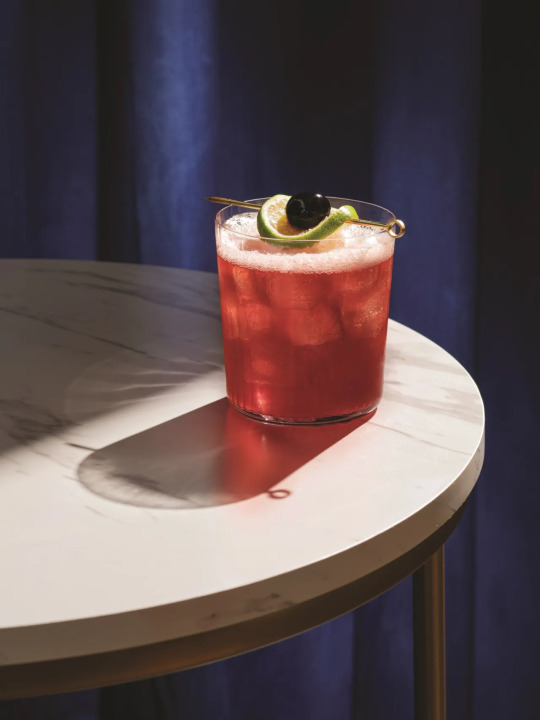
Aside from flavors that are reminiscent of cheerful holiday moods, there is also a tingling and warming sensation from the ginger beer in this Holiday Punch.
Holiday Punch
The headnote says: “Most dark rum alternatives have notes of vanilla and warm spices. Combine this with flavors of cranberry and ginger and it will definitely remind you of the holiday season. Aside from flavors that are reminiscent of cheerful holiday moods, there is also a tingling and warming sensation from the ginger beer. Although an iced drink, it still offers a soothing and relaxing vibe.”
Serves 1
Ingredients:
2 ounces dark rum alternative
½ ounce Simple Syrup (see recipe in Chapter 1)
½ ounce lime juice
1 ounce cranberry juice
3 ounces ginger beer
1 lime wheel and 1 cocktail cherry for garnish
Directions:
1. In a cocktail shaker, combine rum alternative, Simple Syrup, lime juice, and cranberry juice.
2. Add large cubes of ice, cover the shaker, and shake vigorously 10–12 seconds. Shaking not only chills and dilutes the drink but it also tames the acidity of the lime juice a little bit.
3. Fill a double rocks glass 2⁄3 full with ice cubes. 4. Strain the mixture into the glass.
5. Top with ginger beer.
6. Garnish with lime wheel and cocktail cherry. For an extra flair, create a citrus flag garnish. A citrus flag is a citrus wheel wrapped around a cherry, pierced with a cocktail pick.
Mocktail twist: You can substitute the ginger beer with ginger ale for a more subtle flavor. Tonic water can also be used as a substitute for a slightly bitter flavor.
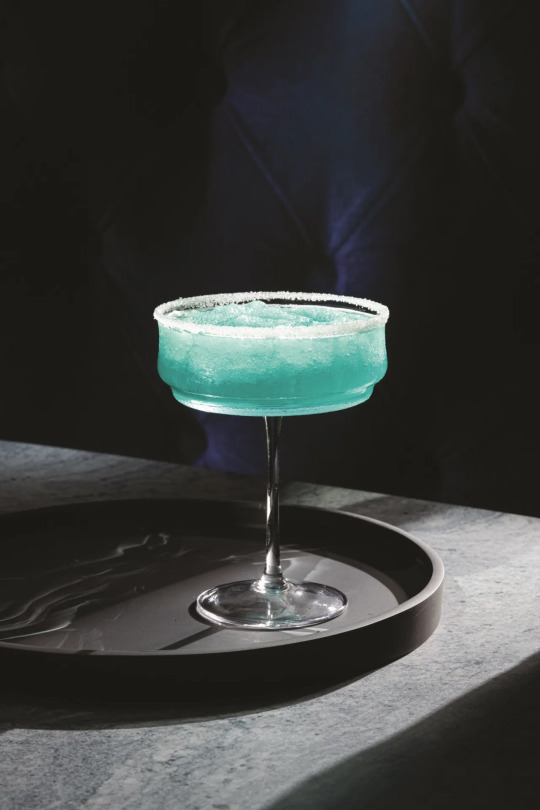
This Jack Frost mocktail uses a blue curacao syrup that doesn’t contain alcohol.
Jack Frost
The headnote says, “You probably have seen a blue cocktail at least once in your life. This blue color usually comes from blue curaçao liqueur, which is a sweet and citrusy spirit. This mocktail uses a blue curaçao syrup that doesn’t contain alcohol. Only a little bit of the blue syrup is used to give it a very light blue color. For a lower-calorie option, you can also substitute the lemon-lime soda with a zero-sugar version.”
Serves 2
Ingredients:
2 ounces tequila alternative
1 ounce nonalcoholic blue curaçao syrup
2 ounces Low-Calorie Lemonade (see recipe in Chapter 1)
3 ounces lemon-lime soda
1 cup regular ice cubes
1 tablespoon granulated sugar for glass rim
1 teaspoon Simple Syrup (see recipe in Chapter 1) for glass rim
Directions:
1. Place two coupe glasses in the freezer, allowing them to chill as you prepare the mocktail.
2. In a blender, add tequila alternative, blue curaçao syrup, lemonade, and lemon-lime soda.
3. Add in ice. Cover and blend until smooth.
4. Place sugar on a small plate. Place Simple Syrup on a separate small plate. Take coupe glasses out of the freezer. Wet the rim of each glass by dipping it in Simple Syrup. Then dip the wet part into sugar.
5. Pour blended drink into the chilled, sugar-rimmed coupe glasses.
Mocktail twist: The rise of blue cocktails is fairly recent. They gained popularity during the latter half of the twentieth century. Blue curaçao is typically used in cocktails and mocktails with citrus or tropical flavors.

This Highland Mule mocktail version of the Moscow mule uses a whiskey alternative as the base spirit, which adds depth to the drink while incorporating notes of oak and vanilla.
Highland Mule
The headnote says: “This mocktail version of the Moscow mule uses a whiskey alternative as the base spirit, which adds depth to the drink while incorporating notes of oak and vanilla. Another key ingredient in any mule is the ginger beer, so it is important to select a good quality ginger beer for this drink. It is best to serve this drink in a copper mug; however, if one is not available, a highball glass will work.”
Serves 1
Ingredients:
2 ounces whiskey alternative
½ ounce lime juice
4 ounces ginger beer
1 dehydrated lime wheel and 2–3 mint sprigs for garnish
Directions:
1. In a copper mug or highball glass, add whiskey alternative and lime juice.
2. Top it off with ginger beer and give it a light stir.
3. Fill the mug or glass with crushed ice using a scoop or a spoon and garnish it by resting lime wheel on the glass rim. Lastly, create a mint bouquet by twisting together mint sprigs. Give mint a light slap on the palm of your hand, and place it on top of the drink.
Mocktail twist: There are many variations of the popular Moscow Mule. They can be made by switching the traditional base spirit (vodka) with a different spirit. The possibilities are many: Jamaican mule (spiced rum), Mexican mule (tequila), London mule (gin), the list goes on. If you prefer a more subtle ginger flavor, ginger ale can be used in place of ginger beer. There are also light ginger beer options for a lower-calorie version of this drink.
Source: Recipes and photos from “The Mocktail Club” by Derick Santiago, Copyright 2024 by Simon & Schuster Inc. Used by permission of the publisher. All rights reserved. Photographs by Harper Point Photography.
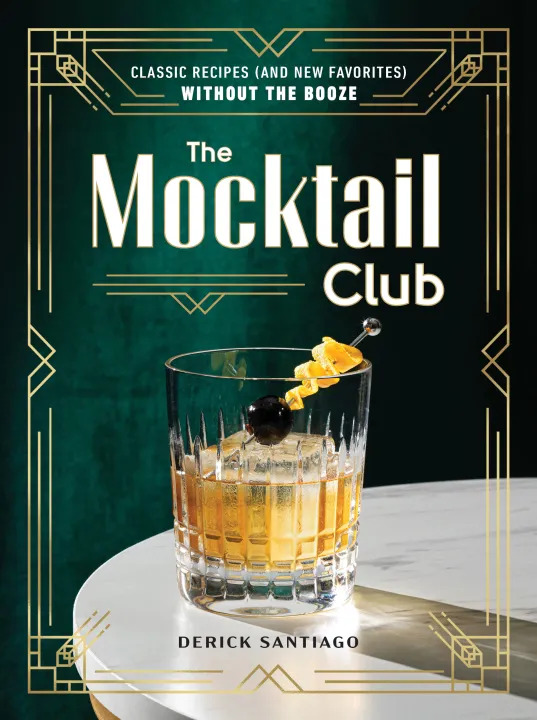
Stephen Fries is professor emeritus and former coordinator of the Hospitality Management Programs at Gateway Community College in New Haven, Conn. He has been a food and culinary travel columnist for the past 15 years and is co-founder of and host of “Worth Tasting,” a culinary walking tour of downtown New Haven. He is a board member of the International Association of Culinary Professionals. Contact him at [email protected] For more, go to stephenfries.com
0 notes
Text
These destinations are a delight for epicureans
Check out my latest column
Editor’s note: Chris Bartlett, co-founder and co-host of Worth Tasting, contributed to this column.
With the New Year upon us, now is the time to plan those 2024 vacations. Here’s a destination to consider, especially for epicureans, those who are passionate about food and drink and unique culinary experiences.
Where beach meets city, and Bayshore Boulevard hugs Tampa Bay, the neighborhoods of Hyde Park Village and Soho (South of Howard Avenue) in Florida rise high like glittering sapphires. Two sparkling gems, shimmering with fantastic facets of art, culture, Southern hospitality and of course, culinary delights. It is here that comfortable walking shoes could be considered your greatest, easiest and most desirous method of transportation.
From the jaw-dropping Bayshore Estates to beautifully appointed and architecturally crafted bungalows, being on foot between the sleek Epicurean Hotel and Hyde Park Village is essential, if one cares to bathe in the magical coziness of both the inviting exteriors of the private homes and sublime commercial hub that punctuate the streets with sizzle and style.
It takes less than two minutes of moving about Soho and Hyde Park Village to know something special is in the air. Somehow, in an instant, life feels easier and friendlier here. A calming happiness seems to spill into its atmosphere.

The Epicurean Hotel at 1207 S. Howard Ave., https://bit.ly/4aCUJqA, was developed in collaboration with the legendary Bern’s Steak House across the street. The hotel’s food theme prevails throughout the property. Wooden sides of wine crates adorn the walls and ceiling at the wine-themed check-in desk. Of course, I was mesmerized by the sitting areas with bookshelves filled with vintage cookbooks available for sale, with proceeds going to a culinary scholarship fund.

Hundreds of handwritten recipe cards have been turned into a work of art in one of the dining rooms at Elevage. (Courtesy of Stephen Fries)
Hundreds of handwritten recipe cards have been turned into a work of art in one of the dining rooms. The artwork throughout the property conveys one of four food themes: grow, create, imbibe and indulge. Even the light fixtures aside the room numbers are etched with food- and wine-related items.
When people think of resorts, they think of golf, spa and theme park resorts. Think of the Epicurean as a culinary resort, with the “theme park” being the world-famous Bern’s Steak House, right across the street.

Even a Christmas tree follows the culinary theme at the Epicurean. (Courtesy of Chris Bartlett)
Cooking and wine classes as well as meetings take place in the state-of-the-art tiered Epicurean Theatre. The late Bern Laxer strongly believed that in the business of food and wine, one must be a student for life.
Edge, the hotel’s rooftop bar, is the place to be to enjoy craft cocktails, wine, beer and small plates. It’s the perfect location for sunset views and taking in eclectic works of art.
The stunning Lobby Bar features chef inspired plates plus a cocktail program that showcases well-made classics, while highlighting creative signature offerings. The Elevage Burger is a fresh take on the classic with cheddar, bread and butter pickles topped with comeback sauce.
We are told the menus change seasonally; however one foodie-favorite dish remains on the Lobby Bar menu; the Homage to Bern’s (shaved ribeye, caramelized onion, Alpine cheese on focaccia), a nod to the Epicurean’s legendary neighbor, Bern’s Steak House.

At the Epicurean’s wine shop, sommeliers will help you find the most interesting wines, many not available in most wine shops. (Courtesy of Stephen Fries)
Bern’s Fine Wines & Spirits is right off the lobby. How convenient! Bern’s Steak House has accumulated one of the largest, private collections of wines assembled in the world. Sommeliers will help you find the most interesting wines, many not available in most wine shops.
Across from the hotel’s entrance is Chill Bros. Scoop Shop. “At Epicurean, we’re all about food and fun, so we’re thrilled to partner with Chill Bros., whose dedication to quality mixes so sweetly with ours,” said the Epicurean’s general manager, Shawn Routen.
Throughout my stay I was eyeing the featured flavors, Malty Millionaire (velvety vanilla malt ice cream filled with bite size millionaire’s shortbread squares and thick swirls of salted caramel), and Apple Pie (cinnamon vanilla ice cream, homemade apple butter, Granny Smith apples cooked to perfection with brown sugar, flakey homemade pie crust sprinkled with cinnamon sugar.) Which would be your choice? Perhaps both . . . need sampling!
Evangeline, the on-site full-service spa, offers a recipe for relaxation with a delectable variety of treatments. The epicurean theme extends here with treatments such as “Champagne Tub & Table for Two,” “Crushed Cabernet Body Treatment,” “Hot Whiskey Scour Massage,” “Bern’s Bourbon on the Rocks Foot Treatment” and what I indulged in, the ”Dulce Delight Body Wrap,” which began with a coffee salt exfoliant of Arabica bean extract that energizes, exfoliates and soothes dry skin.
Then, a full- body, dark-chocolate mask was applied before I was wrapped in a cocoon enhancing absorption and detoxification. After showering off, a sweet cream milk body massage completed the “feast” for the body.
Dinner at Elevage SOHO Kitchen & Bar, the hotel’s restaurant serving breakfast, lunch, dinner and brunch, is headed up by Executive Chef Jonathan Atanacio. As the restaurant website states, “Whether you want to call them epicureans, foodies or gourmands, we’re crafting dining experiences that speak to lovers of life’s great flavors.” We can attest to those flavors with the dinner savored. The pumpkin soup poured tableside incorporated apple, quince, and sage. The pickled beets, served with arugula, feta cheese and cucumber is drizzled with a delicate, red wine vinaigrette. The creative preparation of the roasted Chilean seabass (figs, sunchoke, turnip, pearl onion, apple brown butter) lives up to the quote above with flavors so well-orchestrated.
The Mediterranean Caesar Salad bursts with flavor and color. The Diver Sea Scallops are accompanied with chestnut risotto, kalettes, leeks and just enough tasso butter to tantalize the palate. To top off this epicurean experience, was the Fall Harvest Cobbler (apple, fig, pear, dates, topped with peanut brittle ice cream) and the Flourless Chocolate Brownie adorned with peanut butter swirl ice cream and peanut brittle chocolate sauce. Wine connoisseurs will appreciate the all-encompassing wine list. It is “approachable to the wallet” Atanacio said. Scotch and whiskies number well over 100.

A previous guest described the lobby of the legendary Bern’s Steakhouse as “Harry Potter meets luxury brothel.” (Courtesy of Chris Bartlett)
Eating dinner at Bern’s Steak House is a dining experience like no other. This is a place where the book does not look like the cover . . . Upon entering, you are taken back in time. A previous guest described the lobby as “Harry Potter meets luxury brothel.”
Caviar lovers will be impressed with the 16 choices. If you can’t find a cut of beef to your liking, you won’t find it anywhere. If beef isn’t your thing, there is poultry and seafood. Steak entrees include French onion soup au gratin, steak house salad, baked potato, onion rings and vegetable tasting of the evening, quite often from Bern’s farm.
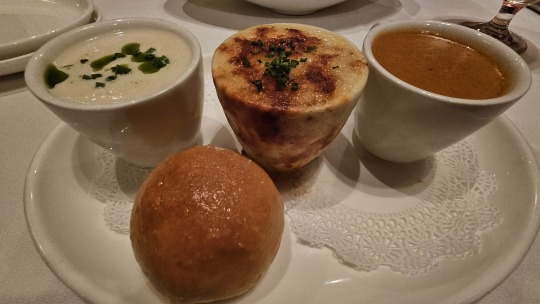
Soup Trio (photo: Chris Bartlett)
I upgraded to the Soup Tasting: a trio of French onion, vichyssoise and lobster bisque. The petit filet mignon, the “turf” of the Surf & Turf was cooked to perfection, a treat for me since I rarely eat beef. I thought, if I was going to enjoy a steak, it had to be here. The “surf” was blackened Day Boat scallops.
My dining partner savored the lump crab cake, chock full of tender crab surrounded by a splash of Green Goddess. An entrée of roasted snapper was accompanied by potato puree, Hen-of-the-Woods (mushrooms), and arugula, topped with white truffle beurre blanc.
Oenophiles will be in paradise with an almost 200-page wine list. Bern’s has 500,000-plus bottles and 6,500 unique labels. Guests can also choose from 150 wines by the glass starting at $10 to a $30,000 bottle. The cellar is one of the most respected and largest collections in the world. After dinner, guests are offered a tour of the massive kitchen and wine cellars. We were given a tour of the meat aging room as well.
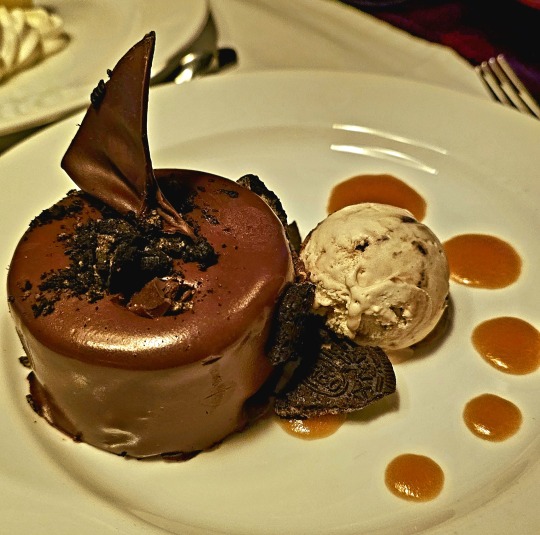
Peanut Butter Truffle (photo: Chris Bartlett)
And then it was off to the Harry Waugh Dessert Room, one of the most famous and popular aspects of Bern’s. I was in heaven, with more than 50 house-made desserts to choose from with more than 1,000 dessert wines and spirits plus creative, specialty coffee drinks. The dessert room was built as a tribute to Harry Waugh, an internationally known and respected wine connoisseur, director of Chateau Latour and good friend to Laxer. California redwood wine holding tanks were used to create private booths. You have to see it to believe it. I indulged with the banana cheese pie, a banana cream cheese mousse in an almond praline crust with fresh bananas and whipped cream. The recipe, which has not changed, dates to 1956, and was one of Laxer’s favorites. The server didn’t have to talk me into trying the Macadamia Nut Ice Cream. This secret recipe was developed by Laxer. He tested and retested the formula hundreds of times before he was satisfied with the results — a sweet, creamy ice cream with buttered, roasted macadamia nuts. Our other dessert, peanut butter and chocolate, a match made in heaven, shone in the Peanut Butter Truffle (Oreo brownie, crunchy peanut butter, peanut butter mousse, caramel milk chocolate mousse, with a generous scoop of peanut butter fudge swirl ice cream). This dessert extravaganza was the crème de la crème!
Everything about Forbici Modern Italian says welcome, and exudes a European charm, from the casual yet modern space to the fresh approach to the most beloved, Italian classics — think scrumptious, house-made pastas, pizzas, sandwiches and salads. This place has character. And it has super-approachable twists on each of these classics thanks to the vision and understanding of fundamental recipes that Executive Chef Raymond Ortiz applies to the creation of each new dish. In his desire to keep things fresh, Ortiz features six new recipes (a pizza, pasta, protein, salad, sandwich and dessert) monthly both to excite his team and to delight his family of customers. From expertly prepared and served fried calamari to the Cup and Char pizza (dough takes three days to be ready and is cut using special scissors, forbici in Italian), we reveled in one taste sensation after another. Beautifully sauced, steamed mussels — so great we wanted to slurp it. Luscious meatballs that were tender, yet flavor packed. The FGT salad (fried green tomato) left us craving for more, that good, and a creative approach for a salad. The most moist and soft textured Lemon Olive Oil Cake ever swept our taste buds far away to Italy, where dining alfresco is one of life’s richest pleasures. And on that sweet note, we bid Chef Raymond, “ciao” as we made our way onto a day made better from the joy and passion we experienced for food and hospitality at Forbici Modern Italian.

At Forbici, the dough takes 3 days to be ready, and pizza is cut using special scissors, forbici in Italian). (Courtesy of Bartlett)

The most moist and soft textured Lemon Olive Oil Cake topped with seasonal berries and whipped mascarpone topped off lunch at Forbici. (Courtesy of Chris Bartlett)
From The Salty (a must!) for an exquisitely tantalizing donut (think decadence) to Oddfellows Ice Cream (Yes, the flavor combinations are that unusual, but amazing) to Buddy Brew (the coffee roaster has a social mission called “Brew Good, Do Good”).
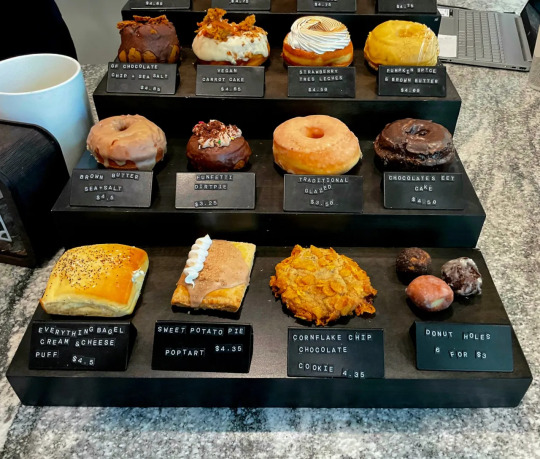
The Salty, for an exquisitely tantalizing donuts (Courtesy of Stephen Fries)
Hyde Park feels like it has an eternal spring of culinary spots popping up for bites, beverages and specialty treats any time of day. While busily walking both to and from our main meals, we couldn’t help ourselves from stopping by to give at least one thing from each place a try.

Oddfellows Ice Cream, where the flavor combinations are creative and is the perfect treat on a warm day. (Courtesy of Stephen Fries)
The Hyppo, creates an array of super-fresh ice pops using every fruit and flavor imaginable. Not only are they visually bursting with vibrant colors, but your taste buds will thank you for the delectable treat. A culinary-merchandise market stop-by at Fig & Julep (one of the best we’ve ever shopped) proved to be a delight. So worth a visit. They have a remarkable, curated collection of local, regional, and national food products from honey to tea, maple syrup to phenomenal soup blends. Truly something special for any foodie.
Finding ourselves needing something to nosh on between meals, we opted to try a freshly made Caprese Panini at Sweet Sorrento. And while it was exactly what we wanted — tasty and like we’ve had in Italy, it took willpower to forgo the menagerie of homemade Italian desserts that was staring out at us.
Mid-afternoon heat drove us into CineBistro for a showing of the 1980s classic film “Planes, Trains & Automobiles.” The elegant theater, complete with a huge, quintessential lobby bar, and eight cinemas, offers in-seat delivery of everything from their full libations and extensive food menus. This place is classy. A fun, tasty and unique experience.
Needing a break from eating, we found ourselves quickly swept up in all the hubbub going on over at The CandlePour. It’s truly exciting and engaging to experience candle making from the focal point of creating “ones unique essential oil blend” then using it to infuse the scent and final aroma the candle will emit. We cannot express how much fun this was. A do not miss stop.
Interestingly, we found ourselves at Goody Goody (a classic diner and part of Tampa’s culinary history), not once, but three times. Breakfast, lunch, dinner, and dessert are all delicious, fresh and plentiful. The flashback theme and servers both give the place a charm and warmth that’s also reminiscent of simpler, happier times, when local, community life meant everything to its people, and gathering at the table fostered good relationships.
With a seemingly endless number of interesting food establishments and diverse restaurants, here are a few that “got away this time” but are high on the list for our next visit. We skipped Bar Taco despite being fans, simply because we’ve enjoyed it before, and in other cities. The Italian Steakhouse, Timpano, was always bustling and had quite the elegant appeal. Since we were already going to Bern’s Steakhouse, it simply was a no-go this time. We were unable to fit in a visit to Haven, the newest member of the Bern’s family, specializing in the concept of crafted, cultured and cellared. From what was mentioned, the menu features fresh, approachable cuisine and a diverse beverage program. The “newish” Meat Market Steakhouse Tampa looks to be very hip and happening with a great crowd, and menu, but we needed one more day in the neighborhood to make it there. The popular On Swann piqued our interest from our first stroll by, with its inviting, minimalist-bistro space. Both the thoughtful lunch and dinner menus would be incredible to eat-our-way-through each subsequent visit.
The sophisticated and delectable looking Ro, with an exquisite, Japanese/Asian menu featuring sushi, sashimi and Korean BBQ, appears to be where we need to eat on our very next night in the neighborhood.
Stephen Fries, is professor emeritus and former coordinator of the Hospitality Management Programs at Gateway Community College in New Haven, Conn. He has been a food and culinary travel columnist for the past 15 years and is co-founder of and host of “Worth Tasting,” a culinary walking tour of downtown New Haven. He is a board member of the International Association of Culinary Professionals. Email him at [email protected] For more information, go to stephenfries.com.
0 notes
Text
‘Baking Yesteryear’ cookbook takes a stroll down memory lane
Check out my latest column

Christmas Crack, from the 1970s chapter, is a confection that longs to sit patiently in a glass jar, eager to offer yet another reason for joy during the season. Dylan indulges here. (Courtesy of Lauren Jones)
‘Tis the season for indulging in our favorite foods, especially decadent desserts, and confections. It’s the time families gather in the kitchen baking their favorite recipes, many handed down through the generations.
These vintage recipes, often written on index cards, tattered and stained from years of use, provoke warm memories of baking with loved ones when we were young. What better way to embrace the season and bring warmth, nostalgia, joy and togetherness to a home. Holiday baking brings back fond memories of simpler and calmer times. It is an escape as well as a connection to the past.
One of the top cookbook titles this year is “Baking Yesteryear: The Best Recipes from the 1900’s to the 1980’s,” by B. Dylan Hollis (2023, DK, a division of Penguin Random House LLC, $32). Hollis’ book will take you down memory lane. The chapters are broken down by decade, beginning with the 1900s and ending with the 1980s.
Hollis shares his favorites from each decade.
1900s: Food for the Gods
1910s: Chocolate Potato Cake
1920s: Ricciarelli
1930s: Whipped Cream Cake
1940s: Applesauce Graham Cracker Torte
1950s: Kiskadee Fantasy
1960s: Haystacks
1970s: Christmas Crack
1980s: The Buster
The final chapter “Worst of the Worst,” is where he writes, “these creations are the kind that make you ponder the sobriety of the recipe developer.” You might be thinking, why were these recipes included? He writes, “I resolved to do so, since the bad experiences of what I do play such a big part in my overall journey of exploring cooking past, and not including them would ignore the fact that some bona fide, published recipes are simply bad — horrendous bad.”
So, what are a few of the recipes included here? Pickle Cheesecake, jellied meatloaf and SpaghettiOs Jell-O Ring (watch these videos at your own risk! https://bit.ly/3Np0cY6 https://bit.ly/48dPage). If you are a fan of these recipes, don’t fret, food is personal, like fashion.
The headnotes to each recipe are intriguing … some history with a good measure of humor as you will see in the recipes shared below.
I had the opportunity to interview Hollis, a larger-than-life personality. The conversation could have gone on and on. Both of us share an interest in vintage cookbooks. I asked how his delight in vintage recipes came about. From a career as a jazz pianist, I thought it was quite a diversion to becoming a baker. Well, he is not just a baker, he is a social media phenomenon with millions of followers patiently (or perhaps impatiently) waiting for his next video showcasing his unique style and humor while cooking. He said it was happenstance.
“During the pandemic I had too much time on my hands and the quarantine caused boredom,” he said.
Hollis always collected old things, including vintage cookbooks. They came in handy to fill the time. One day he looked through a 1912 Canadian cookbook and came across a recipe for pork cake.
“I just stared at it,” he said.
His experiment making the cake on video went viral and the rest is history.
Perhaps these recipes will become part of your holiday repertoire. As Hollis writes in the conclusion of his book, “The experience of putting together Baking Yesterday for you was a pleasure unmatched. Not only as an opportunity to breathe new life into dishes that once held the hearts of those in the old world, but as a celebration of the fact that while the cakes might change, the joys of baking remain timeless. … I sincerely hope that Baking Yesteryear serves you well, and offers you the opportunity to taste just a sliver of the past’s ingenuity, and the magic that I feel comes with it.”
Until my next column, Happy Baking and Happy Holidays!
For the recipe for Potato Chip Cookies from the 1970s visit stephenfries.com/recipes.
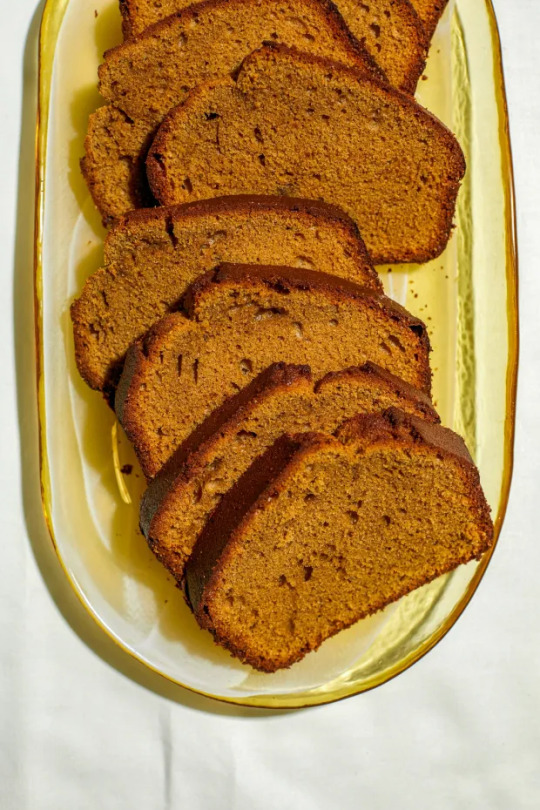
Admiral’s Gingerbread, from the 1910s, is a surprisingly soft, light, and buttery ginger loaf, setting itself apart from traditional dense, dark gingerbreads of yuletide. (Courtesy of Kelley Jordan-Schuyler)
Admiral’s Gingerbread (1910s chapter)
The headnote says, “This is a most peculiar variety of gingerbread, and its bizarre method of preparation seems to have been quite popular along the East Coast cities of the United States in the early 1910s under names like New York Gingerbread and Providence Gingerbread. Bakers will notice that it has an impressively backwards order of operation, but despite this (or because of it), the result is surprisingly soft, light, and buttery ginger loaf, setting itself apart from traditional dense, dark gingerbreads of yuletide.”
9 x 5-inch loaf quick bread
1 cup (225g) butter, softened
1½ cups (210g) all-purpose flour
2 tablespoons ground ginger
3 tablespoons molasses or treacle
Yolks of 5 large eggs, reserve whites
½ teaspoon salt
1½ cups (180g) powdered sugar
1 teaspoon baking powder
Preheat the oven to 350 degrees. Grease a 9×5-inch loaf pan.
In a large bowl, beat the butter until smooth and light. Gradually beat in the flour, ginger, and molasses. Beat until smooth. In a separate bowl, whisk together the egg yolks and the salt. Gradually whisk in the powdered sugar.
In the bowl of a stand mixer fitted with a whisk attachment, or in a large bowl with which an electric hand mixer is to be used, beat the reserved egg whites to stiff peaks. Beat in the baking powder.
Mix the egg yolk mixture into the creamed mixture, before adding the egg white mixture. Beat thoroughly.
Turn into the prepared pan and bake for 50 to 55 minutes, or until a toothpick inserted into the center can be removed cleanly.
Cool in the pan for 10 minutes before transferring to a wire rack to cool completely before slicing.
Christmas Crack (1970s chapter)
The headnote says, “I’ve never before beheld such a perfect meeting of caramel, chocolate, and salty crunch as I did the day I made Christmas Crack. I remember it vividly and has since become my #1 homemade candy. Beginning this recipe by counting and arranging soda crackers in a grid may seem unorthodox, but since the 1970s the making of crack has become a popular yuletide activity for families in the United States…And, just as stockings and candle-glow punctuate the quiet midwinter home, Christmas Crack longs to sit patiently in a glass jar, eager to offer yet another reason for joy during the season.”
40 saltine crackers
1 cup (225g) butter, softened
1 cup (220g) packed light brown sugar
2 cups (340g) semisweet, or milk chocolate chips (one 12oz bag)
Chopped nuts, peppermint candy pieces, M&M’s candies, chocolate bar pieces, or sprinkles, for topping
Preheat the oven to 350 degrees.
Line a large baking sheet with heavy-duty aluminum foil. Arrange a grid of saltine crackers in five rows of eight on the baking sheet. The crackers should all be touching.
Vertically crease the sides of the aluminum foil to create a dam that borders the crackers. In a medium saucepan over high heat, combine the butter and the brown sugar, stirring occasionally until it reaches a boil.
Once the mixture reaches a full boil, boil for 5 minutes without stirring.
Carefully pour the mixture evenly over the saltine crackers. The foil dam will prevent the syrup from spilling .Immediately bake for 7 minutes.
Remove from the oven and quickly sprinkle the chocolate chips evenly over the hot crackers. Allow to sit for 2 minutes, or until the chips appear glossy, indicating they have melted.
Carefully spread the melted chips in a thin, even layer over the crackers.
While the chocolate is still hot, sprinkle on any desired toppings. Chopped walnuts or green and red sprinkles are my favorite options to use.
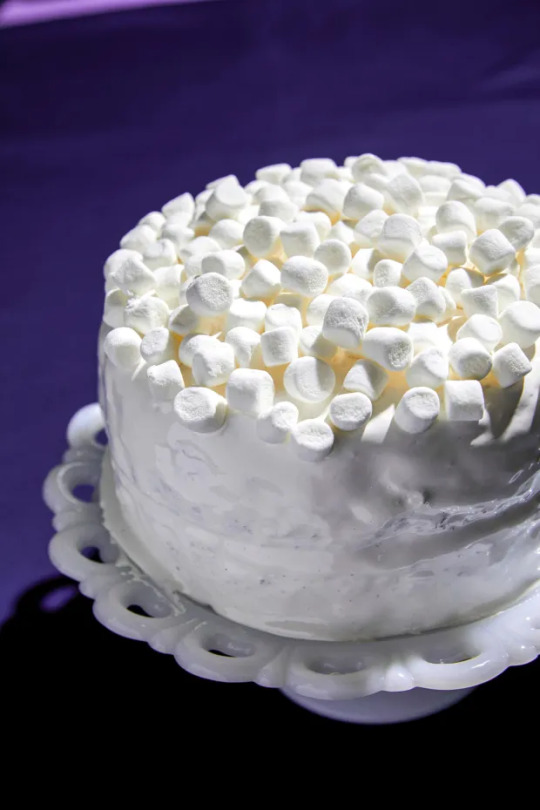
Midnight Mallowmalt Cake from the 1960s has a deep chocolate, marshmallow sweetness, and hints of malt and sour cream tartness. With a snowy blanket of marshmallows and boiled frosting, it is a winner if there’s ever been one. (Courtesy of Kelley Jordan-Schuyler)
Midnight Mallowmalt Cake (1960s chapter)
Makes two 9-inch layers
The headnote says, “Chocolate cakes are an entire world waiting to be explored, and this 1960s example is just as badass as its name. With deep chocolate, marshmallow sweetness, and hints of malt and sour cream tartness, all needed a snowy blanket of marshmallows and boiled frosting, it is a winner if there’s ever been one.”
CAKE
18 marshmallows, or 2 1/3 cups mini marshmallows (¼ lb, 113g)
4 ounces (113g) bittersweet chocolate
¾ cup (180ml) boiling water
3 large eggs
1¼ cups (250g) granulated sugar
2 teaspoons vanilla extract
1½ cups (375g) sour cream
2¼ cups (350g) all-purpose flour
¼ cup (36g) malted milk powder
1½ teaspoon baking soda
1 teaspoon salt
FROSTING
Whites of 2 large eggs
¾ cup (150g) granulated sugar
1⁄3 cup (80ml) light corn syrup
1 tablespoon white vinegar
1 teaspoon vanilla extract
Mini marshmallows, for garnish
Cake Method
Preheat the oven to 350 degrees. Grease two 9-inch cake pans.
Melt together the marshmallows and the chocolate in a double boiler.
Add in the boiling water and beat the mixture smooth. Remove from heat and allow to cool.
In a large bowl, beat together the eggs, sugar, and vanilla until thick and foamy. Blend in the sour cream and the cooled chocolate mixture.
In a separate bowl, combine the flour, malted milk powder, baking soda, and salt. Gradually add to the wet ingredients. Mix until well combined.
Turn into the prepared pans and bake for 25 to 30 minutes, or until a toothpick inserted into the center can be removed cleanly. Cool in the pans for 10 minutes before transferring to a wire rack to cool completely.
Frosting Method
In a large bowl that can be placed atop a double boiler, combine the egg whites, sugar, corn syrup, and vinegar.
Over boiling water, beat the mixture with an electric hand mixer until it thickens and soft peaks form. Remove from heat and beat in the vanilla.
Away from the heat, continue beating until the frosting has cooled and is thick enough to spread onto the cake. This will take some time, about 5 to 6 minutes.
Spread a suitable amount of frosting evenly atop the first cake. Invert the second cake atop the filling to form the second layer.
Frost the assembled cake with the remaining frosting. Decorate the top of the cake with marshmallows.
Recipes excerpted from “Baking Yesteryear,” reprinted by permission of DK, a division of Penguin Random House LLC. Copyright © 2023 by B. Dylan Hollis.)

Stephen Fries, is Professor Emeritus and former coordinator of the Hospitality Management Programs at Gateway Community College, in New Haven, Conn. He has been a food and culinary travel columnist for the past 15 years and is co-founder of and host of “Worth Tasting,” a culinary walking tour of downtown New Haven. He is a board member of the International Association of Culinary Professionals. Email him at [email protected]. For more, go to stephenfries.com.
3 notes
·
View notes
Text
Browsing stores for cookbooks is time well spent
Foodies will love the gift of a cookbook, and it won't be hard on your wallet.
Check out my latest column for gifts those who enjoy food and like to cook
I hope you had a joyous Thanksgiving. For me it was a dual celebration, celebrating my parents’ 68th anniversary, as well. They are snowbirds, so it is a great opportunity to enjoy some warm weather and explore Florida’s food scene while in the Sunshine State. Visiting local bookstores to check out their cookbook shelves, especially those books by local authors and restaurateurs, has been time well spent. One thing I learned years ago, don’t take mom along when I am scouting out cookbooks, since mother is not like son when it comes to cookbooks and cooking. To mom’s credit, she still saves the food section from her local newspaper, so upon my arrival, I have plenty of columns upon which I need to catch-up. Dad, who is 91, on the other hand, enjoys cooking, however, he won’t follow a cookbook recipe, so cookbooks are out for him. I am his “go-to” when it comes to recipes.
With the eight days of Hannukah beginning the evening of Thursday, December 7, and Christmas about three weeks away, the race is on to find that desirous, perfect gift. I am asked by many people, “what cookbook do you recommend for my foodie friends and relatives?” It isn’t easy to pick just a few suggestions. My list is quite extensive; cookbook collecting for me is addictive — I read cookbooks the way one would read a novel. I am sure I am not alone; some people on your gift list — perhaps you, too — are like this. Some of these will fit the bill for a welcome addition to one’s cookbook shelf. And a cookbook gift won’t be hard on your wallet.
For Pennsylvanians, or those that wish to explore the culinary scene in the Keystone State, “Pennsylvania Good Eats: Exploring the State’s Favorite, Unique, Historic, and Delicious Foods,” by Brian Yarvin (2021, Globe Pequot, $21.95) gives the recipient the “tip of the iceberg” of Pennsylvania’s eclectic and vast food culture. The author gives the perfect starting point for exploration. Those who crave food prepared by older relatives now long gone, there is a place out there preparing those dishes, perhaps using techniques now not common. He writes, “Pennsylvania, is so filled with nooks and crannies that any food, no matter how archaic or obscure, can find an out-of-the-way place to thrive. Anytime you hear somebody say, ‘Nobody cooks that anymore!’ you can be sure that somebody in the Keystone State is preparing it.” He mentions scrapple, buckwheat cakes, smoked sausage, and fried noodles. His exploration via car, foot and train made him realize there is no “best.” From John’s Roast Pork Shop (Philadelphia), Appel Valley Butcher Shop (Lancaster), Caputo Brothers Creamery (Spring Grove), Patterson Maple Farms (Westfield) to Mister Ed’s Elephant Museum & Candy Emporium (Orrtanna), you’ll visit food landmarks, where some of your food memories can be rekindled again.
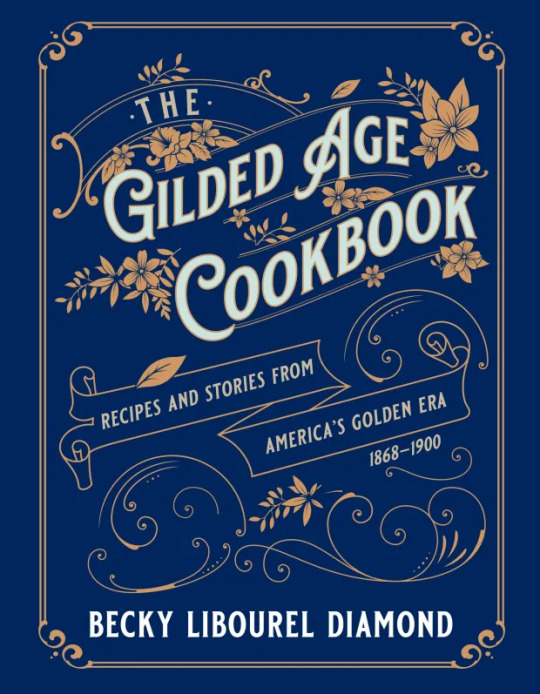
Those interested in food and history will welcome “The Gilded Age Cookbook: Recipes and Stories From America’s Golden Era,” by Becky Libourel Diamond (2023, Globe Pequot, $34.95). This excerpt was contributed by food historian and culinary stylist, Dan Macey: “Theatrics were an integral part of fine dining. Lavish centerpieces, ranging from floral arrangements to ornate sugar molds and plaster-cast animals, were front and center on the banquet table. This same pageantry was often applied to the centerpiece of the meal—the main meat course.” It gives a glimpse of that “perfect” table that impressed guests in the day and still do. I enjoyed the tasteful combination of recipes that are approachable, the artistry and history. The recipient of the book will get a sneak peek of what the Gilded Age looked and tasted like through the beautiful pictures, historic menus, and recipes. My friend, Diane Jacob, the author of “Will Write for Food,” gives the book her thumbs up by saying, “A beautifully designed and photographed cookbook, filled with intriguing stories. The parties and events may have been excessive, but the classic recipes here look simple and doable to make. Bring back a bit of the past and celebrate it today with a copy of “The Gilded Age Cookbook.”
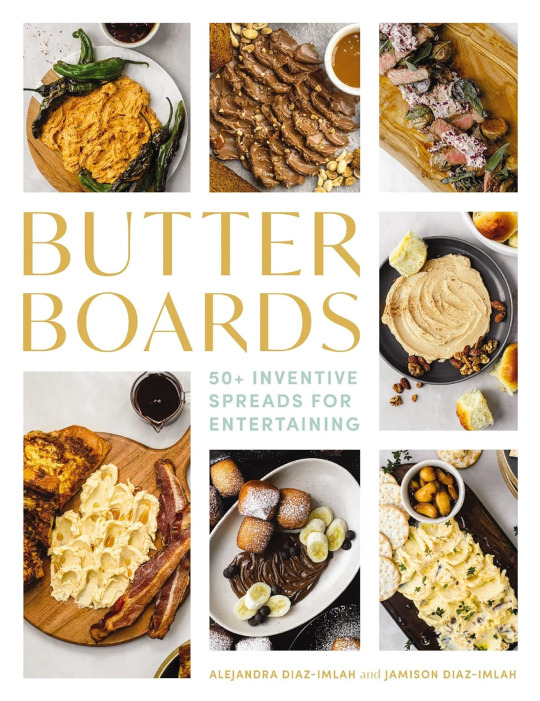
Those on your list who enjoy entertaining, perhaps it is you, a copy of “Butter Boards: 50+ Inventive Spreads for Entertaining,” by Alejandra Diaz-Imlah and Jamison Diaz-Imlah (2023, Cider Mill Press, $27.99) is a must. The “Board craze” is amazing. A plethora of books, websites, and videos, teaching the art of creating food boards (charcuterie, cheese, dessert) are available. There’s even a company that ships beautifully prepared gift boards. Boards make entertaining easy, whether it be for a formal dinner, brunch or a casual afternoon tea. A new concept is butter boards. You might be thinking, what is this? It’s quite simple…softened butter is spread on a board and paired with ingredients, savory or sweet or both. Then, take a piece of bread, a cracker, vegetable or fruit and swipe some delectable butter spread on it. I suggest you use good quality butter for the best flavor. The author describes cultured butter, Irish and European butter as well as plant-based butter, the latter welcomed by vegans and those who don’t eat dairy products. Savory recipes include: bacon butter with bacon and maple biscuits; Christmas butter with radishes and cranberries; pesto butter with rosemary focaccia; dill, caper and cream cheese butter with lox and bagels. For those with a sweet tooth: cinnamon and honey butter with butter rolls and candied almonds; lemon and ginger butter with strawberry rhubarb jam; Spanish chocolate butter with churros.
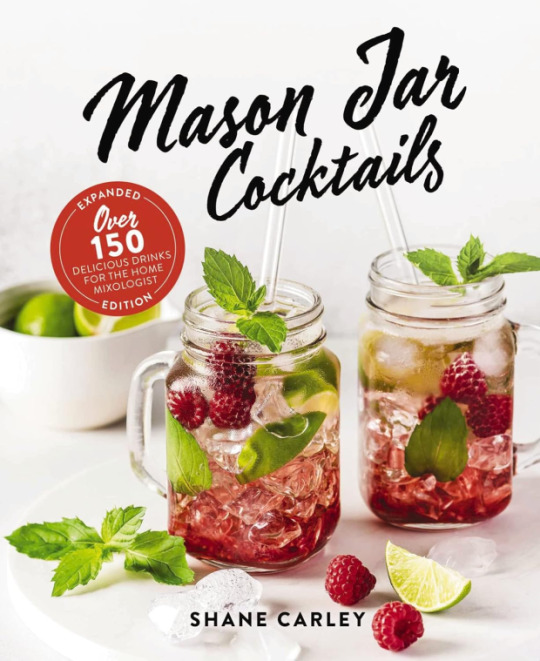
The use of mason jars has gone beyond making and storing preserves. “Mason Jar Cocktails,” by Shane Carley (2022, Cider Mill Press, $19.95) is perfect for those on your list who would like - as the book jacket says, “to combine the best aspects of your favorite creative cocktails with the rustic simplicity of the Mason jar; you’ll be sipping at that martini with country-living style.” Included are cocktails based on a variety of liquors as well as creative mocktails such as Mason Jar Fuzzless Navel and a virgin mudslide.

For the bakers or want-to-be bakers on your list, “I’ll Bring the Cake: Recipes for Every Season and Every Occasion,” by Mandy Merriman (2023, Harvest/HarperCollins, $40) will be a welcome addition to their baking cookbooks, especially those who enjoy or want to learn the art of decorating. The beautiful cakes that are truly works of art, begin with a boxed mix and then several ingredients to the mix. She said, “there’s a special way to make a cake mix taste like it’s from scratch, and my recipes are the best way to make that possible.” What is handy about her recipes is that they can be converted to make cupcakes, Bundt cakes, 9 x 13 inch cakes, etc. The section on buttercream essentials, baking tips and troubleshooting, assembling, and frosting are accompanied by step-by-step photos. One tip that she shares (and I agree with) is to avoid substitutions, with the exception of those avoiding ingredients for allergies. She writes, “I don’t recommend changing a recipe the first time you make it. If you change an ingredient, know that you may end up with a different result.” The flavor combinations are mouth-watering: Cannoli Cake with Cinnamon Mascarpone Buttercream and Ricotta Filling; Creme Brulee Cake with Vanilla Bean Buttercream and Custard Filling; Grapefruit Poppy Seed Cake with Grapefruit Poppy Seed Buttercream and Grapefruit Curd; Gingerbread Cake with White Chocolate and Ginger Buttercream; Eggnog Latte Cake. The stunning photos of every cake will entice the recipient want to make them all!

If you’ve noticed, small plates and tapas are appearing on menus like never before. For many people, this is the preferred way to eat, grazing on a few small plates to experience flavors of different food. Entertaining this way at home, rather than preparing an elaborate meal is the trend. “The Complete Small Plates Cookbook: 300+ Shareable Tapas, Meze, Bar Snacks, Dumplings, Salads, and More,” by the editors of America’s Test Kitchen (2023, $34.99) explains how to put it all together…think about what each dish “brings to the table” (no pun intended), flavor, texture, and color. The recipes are categorized into nibbles, little bites, and heartier bites. The editors give pointers on how to create a small plates menu by asking…What’s the occasion? How much to serve? How much time do you have? The editors share strategies to use when choosing what small plates to prepare. Sample menus, some themed, along with recipes, are provided to make the decision easy. For example: Indian Tea Party (Orange-cardamom spiced nuts; Pakoras with cilantro-mint chutney; Naan with ricotta, sundried tomatoes, and olive tapenade; Gajarachi Koshimbir; pine nut macaroons; Masaka chai). Maybe the recipient will invite you to enjoy the small plates prepared from this gift!

A recent study has shown that Chinese food is the most Googled cuisine in the United States The research, conducted by foodfirefriends.com, analyzed Google search data. Chinese food is Americans’ most-liked food. The ingredients used in preparing Chinese food are now available in many supermarkets due to the popularity of the cuisine, and the number of folks preparing it at home. To assist in this endeavor, Kevin Pang and Jeffrey Pang, the father-son hosts of the video series “Hunger Pangs,” teamed up with America’s Test Kitchen and published “A Very Chinese Cookbook: 100 Recipes from China & Not China (But Still Really Chinese),” (2023, America’s Test Kitchen, $35). General Tso’s Chicken and dumplings to not so well-known dishes, this gift is perfect for people who love Chinese cuisine and would like to prepare it at home. The tips, techniques and step-by-step instructions and illustrations along with the authors’ stories, hosting a Chinese New Year party just might be on the horizon.

With New Year’s Eve around the corner, “Friday Night Cocktails: 52 Drinks to Welcome Your Weekend,” by A.J. Dean (2023, Collective Book Studio, $19.95) is perfect for those cocktail afficionados on your list, especially if they are staying at home to celebrate and wish to experiment with new cocktail ideas. The fifty-two recipes are a collection of classic, contemporary and unique drinks. They are divided by season and month, so the libation can be matched with the weather and holidays. This time of year, the Pumpkin Pie Cocktail, Cranberry Mule or Apple Jack Sour would be appropriate to celebrate the season. The Summer Shandy would be a good choice for the warmer weather. The author writes,“ with a little understanding of the roles of the main components—alcohol, water, sugar, bitters—you can begin to experiment on your own. For example, the French 75 cocktail (gin, lemon juice, simple syrup, sparkling wine); Why not try grapefruit juice in place of the lemon? Or make the same recipe but use different gins?” This joyous holiday season, try something new, but don’t forget the tried-and-true.
Let the shopping begin!
Stephen Fries, is Professor Emeritus and former coordinator of the Hospitality Management Programs at Gateway Community College, in New Haven, CT. He has been a food and culinary travel columnist for the past 15 years and is co-founder of and host of “Worth Tasting,” a culinary walking tour of downtown New Haven, CT. He is a board member of the International Association of Culinary Professionals. [email protected] For more, go to stephenfries.com
0 notes
Text
It’s time to talk turkey, and all the trimmings
Check out my latest column
It's time to talk turkey, and all the trimmings (timesherald.com)
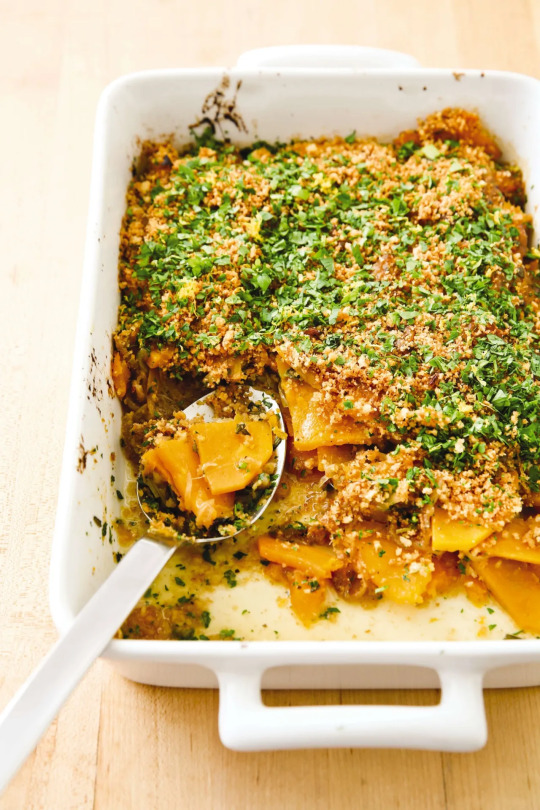
In Butternut Squash Gratin, toasted panko bread crumbs add a nice crunch. (Courtesy of America’s Test Kitchen)
The countdown to Thanksgiving is here, so let’s talk turkey, stuffing, cranberry sauce, sweet potatoes and pumpkin pie.
“Thanksgiving is the meal we aspire for other meals to resemble,” said novelist Jonathan Safran Foer.
Another quote by journalist Nora Ephron: “The turkey. The sweet potatoes. The stuffing. The pumpkin pie. Is there anything else we can agree so vehemently about? I don’t think so.” Great food for thought.
Before I get into the food and recipes, I thought I would share some interesting facts about Thanksgiving. Curious to know how the date came about, I did some research. The holiday was originally celebrated on the last Thursday of November.
And would you believe the date was changed to the fourth Thursday of the month due to the economic factor in years when November has five Thursdays. Here’s a bit of the history about the date change from the Center for Legislative Archives.
“In 1939, however, the last Thursday in November fell on the last day of the month. Concerned that the shortened Christmas shopping season might dampen the economic recovery, President Franklin D. Roosevelt issued a Presidential Proclamation moving Thanksgiving to the second to last Thursday of November. As a result of the proclamation, 32 states issued similar proclamations while 16 states refused to accept the change and proclaimed Thanksgiving to be the last Thursday in November.
“For two years, two days were celebrated as Thanksgiving — the president and part of the nation celebrated it on the second to last Thursday in November, while the rest of the country celebrated it the following week.
“To end the confusion, Congress decided to set a fixed date for the holiday. On Oct. 6, 1941, the House passed a joint resolution declaring the last Thursday in November to be the legal Thanksgiving Day. The Senate, however, amended the resolution establishing the holiday as the fourth Thursday, which would take into account those years when November has five Thursdays. The House agreed to the amendment, and President Roosevelt signed the resolution on Dec. 26, 1941, thus establishing the fourth Thursday in November as the Federal Thanksgiving Day holiday.”
Not all were happy about this change. This Aug. 28, 1939. article from Time magazine talks about the confusion and why calendar manufacturers and football coaches were not happy with the date change. https://bit.ly/36DZejC
Did you know?
• The first Macy’s Thanksgiving parade was in 1924.
• Minnesota raises the most turkeys, followed by North Carolina and Arkansas.
• Seafood was present at the first Thanksgiving, in Plymouth. Mass., a food we rarely see today at the Thanksgiving table.
• Green Bean Casserole was created by the Campbell Soup Co. in 1955
• An estimated 20% of cranberries are eaten on Thanksgiving.
• The average Thanksgiving dinner contains 4,575 calories.
Are you hungry now, or are you getting stressed thinking about the crowd you’ll be hosting in a few days?
Have no fear. These two resources, “Cook’s Illustrated All-Time Best Thanksgiving Recipes” available in the magazine section of your supermarket and magazine stands or at https://bit.ly/3QWs86T, includes recipes that will help you prepare for the biggest cooking day of the year.
You’ll find several recipes for cooking the star of the table: Low-Stress Turkey for a Crowd, Classic Roast Turkey on the Grill (just think, cooking your bird on the grill frees up the oven for cooking all of the sides, and don’t forget those sumptuous desserts); Julia Child’s Turkey, Updated; Easier Roast Turkey and Gravy; Oven-Braised Turkey; Roast Turkey Breast With Gravy (this one works for most of my family, except my dad who prefers the dark meat); Boneless Turkey Breast with Gravy; and those who prefer a smaller bird that cooks much faster, try the Roasted Cornish Game Hens.
You’ll find variations of a favorite, mashed potatoes, and learn how steaming and rinsing potatoes prevents them from becoming gluey. You’re covered with twists on stuffing and sweet potatoes, and the recipe below for a real homemade version of the quintessential Green Bean Casserole. A Thanksgiving table isn’t complete without one!
It will be tough to decide which desserts to make. Will it be one of several apple pie recipes, pear crisp, Pumpkin Cheesecake Perfected or something a bit more basic such as Cranberry-Sour Cream Pound Cake. Check out the recipe for Cranberry Upside-Down Cake at https://bit.ly/32qbeSz.

“Thanksgiving Playbook” by America’s Test Kitchen ($7.95), available as an eBook at bit.ly/46epSxp, focuses on the classic recipes that home cooks say are their go-to favorites — the recipes that their families and friends look forward to seeing on the holiday table year after year.

The five turkey recipes include Old-Fashioned Stuffed Turkey and Easy Roast Turkey Breast with Lemon and Thyme. Butter Fan Rolls and Savory Corn Muffins have the breadbasket covered. The standards: stuffing (recipe below), mashed potatoes sweet potato casserole, pumpkin and apple pies are included. Check out the butternut squash gratin recipe at https://bit.ly/32uc6FH.
Extra-Crunchy Green Bean Casserole
Serves 6-8
Ingredients:
Topping:
½ cup panko breadcrumbs
1 tablespoon unsalted butter, melted
2 ½ cups fried onions
Casserole:
2 pounds green beans, trimmed and cut into 1-inch pieces
3 tablespoons unsalted butter
1 pound cremini mushrooms, trimmed and sliced thin (white mushrooms can be substituted)
1 tablespoon minced fresh thyme
2 garlic cloves, minced
1 ½ teaspoons salt
½ teaspoon pepper
¼ cup all-purpose flour
1 ½ cups chicken broth
1 ½ cups heavy cream
½ cup dry white wine
Directions:
Topping: combine panko and melted butter in a bowl. Microwave, stirring occasionally, until panko is golden brown, about 2 minutes. Let cool completely, then stir in fried onions; set aside.
Casserole: adjust oven rack to middle position, and heat oven to 400 degrees. Combine green beans and ½ cup water in a large bowl. Cover and microwave until beans are just tender, about 8 minutes, stirring halfway through microwaving. Drain beans in a colander; set aside.
Melt butter in a 12-inch nonstick skillet over medium-high heat. Add mushrooms, thyme, garlic, salt and pepper and cook until liquid is nearly evaporated, 6-8 minutes. Stir in flour and cook for 1 minute. Slowly whisk in broth, cream, and wine and bring to a boil. Cook, stirring occasionally, until sauce has thickened, 4-6 minutes. Transfer green beans to a 13-by-9-inch baking dish. Pour sauce over green beans and toss to combine.
Bake until bubbling and green beans are completely tender, about 25 minutes. Remove from oven, top with fried onion mixture, and let cool for 10 minutes.
To make ahead: At the end of step 3, let casserole cool completely. Cover dish with aluminum foil and refrigerate for up to 24 hours. To serve, bake casserole, covered, until green beans are heated through and completely tender, about 40 minutes. Uncover and continue to bake until edges begin to brown, about 10 minutes longer.
Extra-Crispy Skillet Stuffing
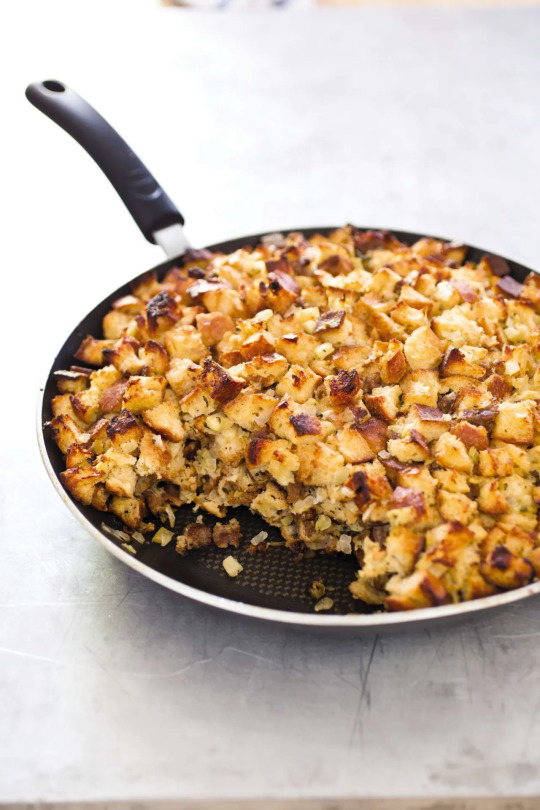
This stuffing has the traditional flavors of onion, celery, sage and thyme. It’s the crispy, crunchy texture that sets it apart. (Courtesy of America’s Test Kitchen)
The headnote says, “To maximize the crunchy, buttery portion of our holiday stuffing, we started by toasting bread cubes (we used a baguette for its high crust-to-bread ratio) in a hot oven, instead of simply drying them out. We then moistened the bread cubes in a mixture of chicken broth and eggs. We melted butter in a skillet, packed in the stuffing, and let it fry for a golden-brown bottom crust. Finally, we brushed the stuffing with melted butter and transferred the skillet to the oven to crisp up the top.”
Note: If your nonstick skillet doesn’t have a metal handle, wrap the handle in a double layer of foil before placing it in the oven.
Serves 8
Ingredients:
1 ½ pounds baguette, cut into ½ -inch cubes (18 cups)
3 ¾ cups chicken broth
4 large eggs, lightly beaten
8 tablespoons unsalted butter
2 onions, chopped fine
3 celery ribs, minced
1 ½ teaspoons salt
1 ½ tablespoons minced fresh thyme
1 ½ tablespoons minced fresh sage
3 garlic cloves, minced
¾ teaspoon pepper
Directions:
Adjust oven rack to upper-middle position and heat oven to 450 degrees. Arrange bread evenly on rimmed baking sheet and bake until light golden brown, 12 to15 minutes, stirring halfway through baking. Let the bread cool completely. Do not turn off the oven. Whisk broth and eggs together in large bowl. Stir bread into broth mixture until evenly coated. Set aside, stirring occasionally, to saturate bread. Melt 2 tablespoons butter in 12-inch, oven-safe nonstick skillet over medium heat. Add onions, celery, and salt and cook until browned, 10 to 12 minutes. Stir in thyme, sage, garlic, and pepper and cook until fragrant, about 30 seconds. Stir onion mixture into bread mixture.
Melt 3 tablespoons butter in now-empty skillet over low heat. Add stuffing to skillet, pressing firmly into even layer with spatula (skillet will be very full). Cook until the bottom of stuffing is browned around edges when lifted with spatula, 7 to 10 minutes. Melt the remaining 3 tablespoons butter in microwave and brush evenly over top of stuffing. Transfer skillet to oven and bake until center of stuffing is hot, and top is golden brown, about 20 minutes, rotating skillet halfway through baking. Let cool for 10 minutes.
Recipes courtesy of America’s Test Kitchen
Stephen Fries is professor emeritus and former coordinator of the Hospitality Management Programs at Gateway Community College in New Haven, Conn. He has been a food and culinary travel columnist for the past 15 years and is co-founder of and host of “Worth Tasting,” a culinary walking tour of downtown New Haven. He is a board member of the International Association of Culinary Professionals. Contact him at [email protected]. For more information, visit stephenfries.com.
0 notes
Text
‘Tis the season for baking pies
Book takes a look at the tasty desserts state by state around the U.S.
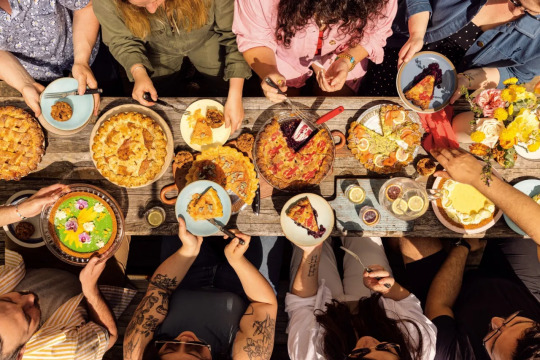
So many pies to bake from the book. (Excerpted from “50 PIES, 50 STATES” by Stacey Mei Yan Fong. Copyright 2023 by Stacey Mei Yan Fong. Photos by Alanna Hale. Food Styling by Caitlin Haught Brown. Used with permission from Voracious, an imprint of Little, Brown and Company.)
Check out my latest column
I asked some friends what food comes to mind this time of the year. Responses include the following: comfort food, apples, everything pumpkin and pies. Walk into any supermarket, and you’ll see displays of ingredients to make the perfect pie.
As the holiday baking season approaches, home bakers are digging out and dusting off their pie baking gear, many of them heirlooms handed down from family bakers.
What’s better on a cold day than to have a pie baking in the oven, warming-up the house, coupled with the aroma of cinnamon and spice to dispel the winter blues?
Ask anyone what their favorite part of Thanksgiving and Christmas dinner is, and most often it’s pie that sits atop the list. We seem to have a love affair with it. Families pass on the tradition of pie making from generation to generation.
Making the crust often is the biggest challenge, thus it can cause a fair amount of fear. With trial and error, making perfect pies possible. And if rolling out the dough is something you feel is out of your comfort zone, a pressed crust is an easy alternative for a single crust pie.
The crumble, crisp or cobbler are alternatives to a traditional pie. Whether it be a sweet fruit pie or a savory one such as chicken potpie, the nostalgic association with the pies we savor can evoke feelings of comfort and love.
On the lookout for this year’s cookbook for this feature, I was intrigued with the title, “50 Pies, 50 States: An Immigrants Love Letter to the United States Through Pie” by Stacey Mei Yan Fong (2023, Voracious an imprint of Little, Brown and Company, $35).
Consider the book as a mouthwatering “pie” road trip throughout the United States. The author took her Instagram project where she baked a pie for each state based upon ingredients that define it. Her project culminates with the book’s publication.
There are U.S states that have an official pie; Florida’s is key lime; shoofly is Pennsylvania’s, and apple is Vermont’s. You’ll probably agree that different regions and cultures each have unique pie traditions. What makes the book so much more than a cookbook are the dedication comments for each recipe as well as the information about the state and the inspiration for each pie.
During a recent interview, Stacey mentioned that every bite of a pie transports us to the people and places that mean the most, no matter where in the world we are. I learned that she was searching for what she could call home when moving to the U.S., where she earned her degree at the prestigious Savannah College of Art and Design (SCAD).
Stacey was born in Singapore, raised in Indonesia and Hong Kong. For some reason, she felt that she didn’t have roots. Moving to the U.S., she was able to understand what home could mean.
After quitting her handbag design career, she began her culinary vocation, baking at Four and Twenty Blackbirds, the famous Brooklyn, N.Y., pie shop. This job gave her the idea for the project “50 Pies, 50 States”. The undertaking offered her a sense of home and an appreciation for the United States, what Stacey calls her adopted home. It was interesting to learn that where she grew up, pies are a savory dish.
Her creations are impressive and whimsical, incorporating the state’s flavors.
When asked what the two pies from the book one should put on the top of the list to bake, she said, “Your home state’s pie and the Brooklyn pie (Scallion Bagel Pie).”
In addition to the 50 states, Stacey pays homage to the places she’s lived by creating a pie recipe: Singapore, Indonesia, Hong Kong, Savannah, Ga., and her home for the past 13 years, Brooklyn. She encourages you to be creative when making the Brooklyn Bagel pie, by incorporating ingredients enjoyed on a bagel.
How about these creative pies (using flavor combinations that intrigue me.)
California’s artichoke pie with savory lemon crumble and red wine reduction. It is a nod to the flavors of Sonoma County. Maine’s blueberry and Moxie Pie is inspired by the state’s abundant harvest of berries as well as Moxie, the official soft drink of the state.
Maryland’s Blue-Crab-Dip Pie with Hot Old Bay crust pays homage to crab, the state’s most famous food. Old Bay was invented by a German refugee who came to Maryland in 1939 and named the blend after the ship line on the Chesapeake Bay.
The Nevada pie, well it is extravagant and excessive. I’ll keep this one at bay until you get the book, but here’s a hint…think “all you can eat buffet.”
I bet your mouth is watering by now….so let’s turn on the oven and bake a pie!

Maple Pumpkin Pie (New Hampshire’s Pie) With Painted Birch Tree Crust
Makes 1 pie
Ingredients:
Crust:
All butter crust (double recipe below), one for bottom of pie, rolled out, fit into 10-inch pie pan, and crimped, one for birch tree crust design.
Filling:
1 cup maple syrup
1 (15-ounce) can (1 7/8 cups) pumpkin (preferably Libby’s)
1 cup heavy whipping cream
2/3 cup whole milk
2 large eggs
1 teaspoon ground cinnamon
1 teaspoon ground ginger
½ teaspoon kosher salt
2 teaspoons ground espresso powder for birch trees
Small paintbrush
x-acto knife to cut birch tree design
Directions:
Make the filling: In a medium saucepan over medium heat, gently bring the maple syrup to a boil. Turn the heat off and let the maple syrup cool slightly. In a large mixing bowl, whisk the cooled maple syrup, pumpkin, cream, milk, eggs, cinnamon, ginger and salt. Set aside until ready to fill the pie.
Assemble and bake the pie: Preheat oven to 375 degrees. Place the prepared crust on a baking sheet and pour filling into the crust. Bake on center rack for 1 hour until the filling is set but has a slight jiggle. Cool completely.
Make the birch tree decorations: While the pie is cooling, use the birch tree template to cut trees out of the rolled-out top crust. Place the cut out trees onto a flour dusted baking sheet. Mix two teaspoons ground instant espresso with 1 tablespoon water and use a clean paintbrush to paint on tree details. Freeze the finished trees for 230 minutes. Bake in the 375-degree oven rotating 180 degrees halfway through for 20-30 minutes, until golden brown.
Finish the pie: Place the birch trees on the cooled pie. Enjoy with whipped cream.
All-Butter Crust
The headnote says: “Crust is the foundation of all your pies. Bakers have their preferences of which fat to use, but I’m all about the butter, baby. Fat is flavor and using a butter with high fat percentage when making your dough means a pie crust that you’re gonna wanna eat crimp first!”
All-Butter Crust (single)
1¼ cups unbleached all-purpose flour
½ teaspoon kosher salt
1 ½ teaspoons granulated sugar
½ cup (1 stick) cold unsalted butter, cut into ½ -inch pieces
½ cup cold water
2 tablespoons cider vinegar
½ cup ice
All-Butter Crust (double)
2 ½ cups unbleached all-purpose flour
1 teaspoon kosher salt
1 tablespoon granulated sugar
1 cup (2 sticks) cold unsalted butter, cut into ½ -inch pieces
1 cup cold water
¼ cup cider vinegar ½ cup ice
Sift flour, salt, and sugar together in a large bowl with a flat bottom. Add the butter pieces on top of the dry ingredients. Using your fingers, too the butter in the dry mixture so each cube is coated. Use a pastry blender or your fingers to cut or rub the butter into the mixture until it is pieces a bit larger than peas (a few larger pieces are okay; be careful not to over-blend). You want to be able to have big butter chunks in your crust: it helps to create a flaky effect, as well as adding delicious buttery hits of flavor!
In a separate large measuring cup or small bowl, combine the water, cider vinegar, and ice. Sprinkle 2 tablespoons of the ice water mixture over the flour mixture; do not add the ice, which is just there to keep your water cold. Using your hands in a circular motion, bring the mixture together until all the liquid is incorporated. Continue adding the ice water mixture, 1 to 2 tablespoons at a time. Carefully mix until dough comes together in a ball, with some dry bits remaining. Turn dough out onto a lightly floured surface and knead gently until it comes into one mass; you don’t want to overwork it.
Shape dough into a flat disc (if making double recipe, first separate dough into two equal portions), wrap in plastic, and refrigerate for at least 1 hour, preferably overnight before using.
Wrapped tightly, the dough can be refrigerated for 3 days or frozen for up to 3 months. Thaw frozen dough overnight in refrigerator.
Excerpted from “50 pies, 50 states” by Stacey Mei Yan Fong. Copyright 2023 by Stacey Mei Yan Fong. Photos by Alanna Hale. Food Styling by Caitlin Haught Brown. Used with permission from Voracious, an imprint of Little, Brown and Company.

0 notes
Text
Regional branding: Cream cheese adds a tasty twist to Philly flavors
Champagne, San Pellegrino, Cape Cod Potato Chips, Seattle’s Best Coffee, Texas Pete Hot Sauce, Brooklyn Bagels, Philadelphia Cream Cheese… the list of food and drink products named after geographic locations could go on and on. Why? Perhaps it is to give the consumer assurance of quality associated with a locale. Or, in many cases named after the geographic region where they are produced. For example, Parmesan Reggiano cheese is produced in the provinces of Parma and Reggio Emilia, Italy or to be considered Swiss chocolate, the production must take place in Switzerland. Did you know Champagne must be produced in the Champagne region of France to be called Champagne; hence, Champagne is sparkling wine, however not all sparkling wine is Champagne.
Well, when it comes to Philadelphia cream cheese, you might be surprised that this famous brand did not originate in its namesake. It was in 1872 when a farmer named William Lawrence, from Chester New York invented Philadelphia cream cheese…and it was by accident. He was preparing some Neufchâtel and his result was smoother and not as crumbly as what he set out to make. Voila, cream cheese was born! Why did he brand it “Philadelphia” cream cheese? …at the time, the city was known for premium quality dairy products.
The beloved brand hasn’t changed its well-known packaging much over the years…you know, the rectangular silver box and silver foil encasing the cheese.
The use of cream cheese goes beyond the schmear on a bagel. Used as a base for dips, cheeseballs, an ingredient in soups and sauces and of course a plethora of desserts and cheesecakes, it is so versatile and can be a blank canvas for so many creations. It was surprising to learn that cream cheese is one of the five most popular cheeses in the United States.
The company’s website shares some milestones:
1939: The classic Philadelphia brick was introduced
950s: Cheesecake was introduced as a mainstream dessert in the U.S.
1971: Philadelphia whipped cream cheese hits the shelves for the first time
1981: Philadelphia soft cream cheese is introduced
2013: At the 9th annual cream cheese festival, the company created a 6,900-pound cheesecake and obtained the Guiness World Record for the world’s largest cheesecake
2017: Philadelphia cheesecake cups and Philadelphia bagel chip & cream cheese dip were launched to fulfill all of your sweet and savory snacking cravings.
2021: Philadelphia cheesecake crumble dessert was launched
2022: Philadelphia celebrated its 150th anniversary
Many cookbooks have been published with recipes using this iconic brand. Of course, as you might already know from reading my columns, this cookbook collector has a few in his ever-expanding collection.
Here are a few ideas and recipes.
Take whipped cream cheese and mix with chopped bacon, horseradish, and chives. Stuff large mushroom caps with the mixture or use as a dip for vegetables.
I add a bit of softened cream cheese when making scrambled eggs or mashed potatoes.
Make a quick Alfredo sauce by taking 8 ounces of cream cheese, a cup of Parmesan cheese, ½ cup butter, ½ cup of milk and salt to taste and cook over low heat until it becomes a smooth consistency. Add salt and pepper to taste.
Make an apple or other fruit dip by taking a package softened cream cheese and mixing it with brown and white sugar to taste, and a teaspoon of vanilla.
This recipe for fudge was written on a napkin and filed in an old recipe box I have.
Slowly add 4 cups of confectioners’ sugar, to 1 (8-ounce) package cream cheese, softened and mix until combined. Stir in 4 (1-ounce) squares unsweetened chocolate (melted), 1 teaspoon pure vanilla extract and ½ cup chopped walnuts. Spread the mixture in an 8-inch pan and put in refrigerator until chilled and hardened. Cut into squares.
This recipe is from “Philadelphia Brand Cream Cheese: All New Simple & Elegant Recipes” (published 1990)
Southwestern Cheesecake
The headnote says, “All of your favorite southwestern ingredients in a savory cheesecake.”
1 cup finely chopped tortilla chips
3 tablespoons Parkay margarine
2 (8-ounce) packages Philadelphia cream cheese, softened
2 eggs
1 (8-ounce) package Kraft shredded Colby/Monterey Jack cheese
1 (4-ounce) can chopped green chilies, drained
1 cup sour cream
1 cup chopped yellow or orange pepper
½ cup scallion slices
1/3 cup chopped tomatoes
¼ cup pitted ripe olive slices
Preheat oven to 325 degrees
Stir together chips and margarine in a small bowl; press onto bottom of 9-inch springform pan. Bake for 15 minutes.
Beat cream cheese and eggs in a large mixing bowl at medium speed with an electric mixer until well blended. Mix in shredded cheese and chilies; pour over crust. Bake for 30 minutes.
Spread sour cream over cheesecake. Loosen cake from rim of pan; cool before removing rim of pan. Chill.
Top with remaining ingredients before serving.
To make an attractive design on top of this cheesecake, simply cut three diamonds out of paper. Place on top of cheesecake. Place scallion slices around diamonds. Remove cutouts; fill in with peppers. Add a strip of tomatoes down the center. Garnish with olives
The following recipe is from “Philadelphia Brand Cream Cheese” Cheesecakes (published 1989)
Coconut Choco Cheesecake
1 cup graham cracker crumbs
3 tablespoons sugar
3 tablespoons Parkay margarine
Combine crumbs, sugar and margarine. Press onto bottom of 9-inch springform pan. Bake at 350 degrees for 10 minutes.
2 (1-ounce) squares unsweetened chocolate
2 tablespoons Parkay margarine
2 (8-ounce) packages Philadelphia cream cheese, softened
1 ¼ cups sugar
¼ teaspoon salt
5 eggs
1 (3 ½ ounce) can flaked coconut*
Melt chocolate and margarine over low heat, stirring until smooth. Cool. Combine cream cheese, sugar, and salt, mixing at medium speed with an electric mixer until well blended. Add eggs, one at a time, mixing well after each addition. Blend in chocolate mixture and coconut; pour over crust. Bake at 350 degrees for 1 hour.
1 cup sour cream
2 tablespoons sugar
2 tablespoons brandy
Combine sour cream, sugar, and brandy. Loosen cake from rim of pan; cool before removing rim of pan. Chill. Garnish with chocolate shavings, if desired.
You might be wondering why margarine was used in these recipes. Back in the day when these recipes were published, it was a popular ingredient to use. Today, butter has replaced margarine in most recipes.
*Some products from older cookbooks might not be available, so if you can’t find canned flaked coconut, you can use the bagged version.
For the recipe for Lattice Cherry Cheesecake from “Philadelphia Brand Cream Cheese Cheesecakes”, visit https://stephenfries.com/recipes

The next recipe is from “Best Recipes From The Backs of Boxes, Bottles, Cans & Jars,” by Ceil Dyer (published 1979)
Vanilla “Philly” Frosting
1 (8-ounce) package Philadelphia Brand cream cheese, softened
1 tablespoon milk
1 teaspoon vanilla
Dash of salt
5 ½ cups confectioners’ sugar, sifted
Blend together softened cream cheese, milk, vanilla and salt. Add sugar, one cup at a time, mixing well after each addition. Fills and frosts two 8 or 9-inch cake layers.
Variations:
Substitute 1 teaspoon almon extract for vanilla.
Stir in ¼ cup crushed peppermint candy.
Stir in ¼ cup crushed lemon drops and 1 teaspoon lemon juice.
For more recipes, visit https://www.creamcheese.com/recipes
Stephen Fries, is Professor Emeritus and former coordinator of the Hospitality Management Programs at Gateway Community College, in New Haven, CT. He has been a food and culinary travel columnist for the past 15 years and is co-founder of and host of “Worth Tasting,” a culinary walking tour of downtown New Haven, CT. He is a board member of the International Association of Culinary Professionals. [email protected] For more, go to stephenfries.com.
1 note
·
View note
Text
The pastabilities: October is best time to celebrate pasta
Check out my latest column...celebrate National Pasta Month
October is the month to celebrate one of America’s favorite foods, pasta.
A survey conducted by the National Pasta Association (NPA) shows 73% of respondents said they eat pasta at least once a week. Perhaps that is because of its versatility, value, and health factors. When respondents were asked what food, they could not live without, 60 percent chose pasta — even beating out chocolate.
Pasta’s history is as varied as its shapes. According to the NPA, “While widespread consumption is documented from the 14th century, it is believed to have existed in some form in ancient China and Greece. And evidence of pasta dishes appeared in Italian recipe books in the early 1200s.” Many pasta shape names have interesting translations…did you know “farfalle” means butterflies and “penne” means quills? Perhaps it is an everyday object inspiring a pasta shape…”radiatori” pasta looks like a radiator….”fusilli” mirrors a screw and ”orecchiette” resembles a small ear.
Celebrate National Pasta month by trying some new shapes of pasta and recipes or prove to everyone you’re the ultimate pasta aficionado with these facts.
— Americans eat approximately 20 pounds of pasta each year. But wait in Italy, the average person eats 51 pounds.
— The first American pasta factory was opened in Brooklyn in 1848. It was not an Italian that started the U.S. industry, rather, a Frenchman named Antoine Zerega.
— Americans named spaghetti as their favorite pasta shape.
— 54 percent of Americans always keep 1-4 packages of pasta in their pantry.
— According to a National Pasta Association analysis, the average price an American pays for pasta is about $1.45 per pound. This makes it one of the most affordable meal options.
— According to statista.com, in 2021, the United States was the second-largest pasta-producing country in the world (2,000,000 tons) Guess who was #1? Of course, it was Italy with almost 4,000,000 tons!
— According to a recent Grain Foods Foundation survey of more than 1,000 U.S. adults representing a cross-section of the population, approximately one-third of consumers named pasta (36 percent) and bread (29 percent) as foods that are comforting during a stressful time.
Have some fun…. experiment with creative recipes using pasta…..
Pasta pancakes: Take some cooked, thin pasta (angel hair or spaghetti), coarsely chop and then combine with beaten eggs, grated cheese, fresh herbs and to make a pancake batter. In an oiled frying pan, prepare like you would make a pancake.
Dessert pasta: Cook chocolate pasta (yes, there is such a thing). Heat Nutella or other hazelnut spread with a bit of heavy cream to make it a smooth consistency and mix with the cooked pasta. Top with chopped hazelnuts or walnuts and whipped cream. Top it off with a cherry.
There are gluten-free pastas (if you haven’t tried Aldi’s, you won’t be disappointed) and pastas made from barley, buckwheat, rye, rice, maize, chickpea, and other flours. It is available dried, fresh, frozen, and canned (think Chef Boyardee). By the way, it is not a fictitious name, though the spelling is a bit different — Ettore Boiardi. It was interesting to learn that Boiardi worked his way up to head chef at the renowned Plaza Hotel in NYC. That is quite a step up from canned spaghetti for which he was known.
One of the fun aspects of celebrating food holidays is finding appropriate books on my shelves and looking through them for cooking ideas. I also enjoy finding products, especially new ones, to use in cooking with the celebrated item. It was fun taking another look at the book based on the popular YouTube channel of the same name, “Pasta Grannies: the Secrets of Italy’s Best Home Cooks,” by Vicky Bennison (2019, Hardie Grant Books, $29.99). The collection of Italian recipes from 75 nonnas from all over Italy transported me into the heart of their homes, the kitchen, and provoked memories of my trip to Italy.
Handmade pasta styles range from Giuseppa’s pici (a very thick spaghetti) that is simple to make to Anna’s lumachelle della duchessa (tiny, ridged, cinnamon scented tubes). What makes this cookbook great is the extraordinary stories of these ordinary women and shows you how with the right know-how and a few good ingredients, truly authentic Italian cooking is simple, beautiful, and achievable.
“Pasta: The Ultimate Cookbook,” by Serena Cosmo (2017, Cider Mill Press, $39.95), might just become your pasta “bible.” The 800-page volume details the origins and uses of 350 types of pasta and noodles from around the world, as well as the ingredients and equipment that can be used to make your own. Several pages cover the art of cooking both dried and fresh pasta. I learned that the mineral content and temperature of water used in making your own pasta can affect the quality of the dough. It made me think, it might be the same reason Brooklyn bagels are considered the best by many of us. As you will see, the author’s in-depth headnotes for the recipes add to the enjoyment of the book.

In the forward, she writes, “A great wish of mine is that you, the reader, will find inspiration in the pages of this book. Inspiration that turns into a pasta, noodle, or dumpling dish so delicious that it makes your loved one’s smile, perhaps even purr, as you all enjoy a wonderful meal together. Good food is such a satisfying unifier. But enough talk, let’s make some pasta together!” Here are two recipes from the book.
Fettuccine Alfredo
The headnote says, “This iconic Italian American pasta dish was invented in 1914 by a Roman restaurateur named Alfredo di Lelio. Desperate to have his pregnant and nauseous wife eat something, he cooked up some fettuccine and seasoned it with butter and Parmigiano Reggiano. When his creation got his wife eating again, he decided to put the simple dish on his restaurant’s menu and named it, very humbly, after himself. (Why not after the woman carrying his child, I’ll never know.) Shortly thereafter, Mary Pickford and Douglas Fairbanks, two Hollywood silent film stars in Rome on their honeymoon, wandered in for a bite to eat and fell in love again . . . with this dish.
It didn’t take long for word to get out in the States, bringing Mr. di Lelio a parade of vacationing movie starlets along with troupes of well-heeled tourists intent on rubbing elbows with Hollywood royalty. Ironically, despite its birthplace, fettuccine Alfredo has become a much more popular dish in the United States than it ever has been in Italy. This is perhaps because, unlike the plainer Italian version, which contains only butter and Parmigiano and is served predominantly to young children and convalescing adults, the Italian American version added lavish amounts of heavy cream somewhere along the way. This version stays faithful to its Italian origins and gets its creaminess from the emulsion between the melted butter, grated cheese, and starchy pasta water.”
4 ½ tablespoons unsalted butter, divided
Salt
¾ pound fettuccine or other long pasta
1 cup freshly grated Parmigiano-Reggiano cheese, plus more for serving
Freshly ground black pepper
Cut the 4 tablespoons of butter into 4 pieces and set aside to soften as you cook the pasta.
Bring a large pot of water to a boil. Once it’s boiling, add salt (1 tablespoon for every 4 cups water) and stir. Add the fettuccine and stir for first minute to prevent any sticking. Cook according to the package instructions, draining the pasta 2 minutes short of the directed cooking time. The pasta should be tender but still very firm.
About 4 minutes before you will need to drain the fettuccine, transfer 1 cup pasta water to a skillet large enough to hold the finished pasta dish. Bring to a gentle simmer, then whisk in the butter, a piece at a time, until emulsified. Whisking constantly, gradually add the Parmigiano, making sure what you’ve added is completely melted and incorporated into the sauce before adding more (caution: rushing this part creates globs of cheese in the sauce)
Drain the pasta, reserving ½ cup of the pasta water (though you will most likely not need all of it). Return the empty pot to the stove and immediately turn the heat to high. Add the remaining ½ tablespoon butter and ¼ cup of the pasta water. Quickly add the drained pasta and toss until all the liquid at the bottom of the pot has been absorbed.
Transfer the pasta to the skillet with the cheese sauce and toss to coat, adding more of the pasta water as needed, until the noodles are evenly coated.
Divide the fettuccine among four warmed bowls. Serve piping hot, dusted with a good crack or two of pepper and more Parmigiano (or pass the grated cheese at the table. Makes 4 servings.
Herbed Couscous Pilaf with Cranberries and Pine Nuts
The headnote says, “This tasty and aromatic side dish pairs beautifully with grilled meats and fish; I also like it as a side for a frittata. It’s a big hit with kids too.”
1 tablespoon extra-virgin olive oil
4 shallots (about 5 ounces), minced (about 1 cup)
Salt
1 cup couscous
1 ¼ cups chicken or vegetable broth
½ cup pine nuts
Handful chopped fresh parsley
Leaves from 2 sprigs fresh thyme, chopped
¼ cup dried cranberries
Heat a small saucepan over medium heat for 2 to 3 minutes. Add the olive oil and let heat for a minute. Add the shallots and a pinch of salt and cook, stirring a few times, until tender, about 5 minutes.
Raise the heat to medium-high, stir in the couscous, and cook for a minute. Add just enough broth to cover the couscous by ¼ inch. Add salt to taste, stir, and bring to a boil. Cover, remove from the heat, and let rest for 5 minutes.
As the couscous rests, toast the pine nuts. Put them in a skillet over medium heat. Stir continuously with a wooden spoon until they acquire a golden color, 4 to 5 minutes. Add a pinch of salt and stir well. Remove from the heat and let cool.
Fluff the couscous with a fork and transfer to a serving bowl. Stir in the parsley, thyme, cranberries, and pine nuts until well combined and serve. Makes 8 servings as a side dish.
Stephen Fries, is Professor Emeritus and former coordinator of the Hospitality Management Programs at Gateway Community College, in New Haven, CT. He has been a food and culinary travel columnist for the past 15 years and is co-founder of and host of “Worth Tasting,” a culinary walking tour of downtown New Haven, CT. He is a board member of the International Association of Culinary Professionals. [email protected] For more, go to stephenfries.com.
1 note
·
View note